Literature Review on Capital Budgeting and Price Volatility
VerifiedAdded on 2023/03/20
|28
|9052
|59
AI Summary
This literature review analyzes the research on capital budgeting techniques and their limitations in the face of price volatility. It explores theories, models, and recent research in this area.
Contribute Materials
Your contribution can guide someone’s learning journey. Share your
documents today.
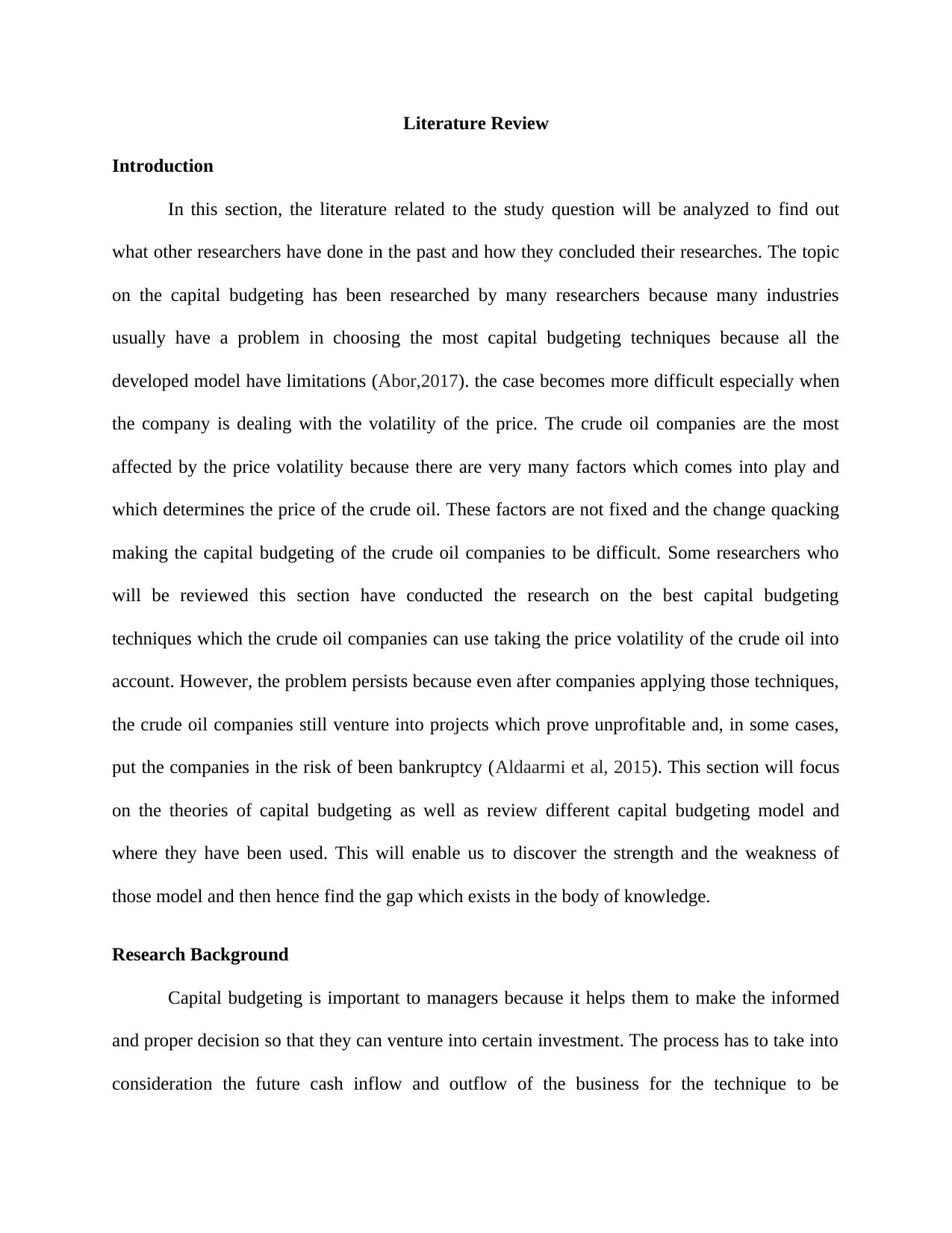
Literature Review
Introduction
In this section, the literature related to the study question will be analyzed to find out
what other researchers have done in the past and how they concluded their researches. The topic
on the capital budgeting has been researched by many researchers because many industries
usually have a problem in choosing the most capital budgeting techniques because all the
developed model have limitations (Abor,2017). the case becomes more difficult especially when
the company is dealing with the volatility of the price. The crude oil companies are the most
affected by the price volatility because there are very many factors which comes into play and
which determines the price of the crude oil. These factors are not fixed and the change quacking
making the capital budgeting of the crude oil companies to be difficult. Some researchers who
will be reviewed this section have conducted the research on the best capital budgeting
techniques which the crude oil companies can use taking the price volatility of the crude oil into
account. However, the problem persists because even after companies applying those techniques,
the crude oil companies still venture into projects which prove unprofitable and, in some cases,
put the companies in the risk of been bankruptcy (Aldaarmi et al, 2015). This section will focus
on the theories of capital budgeting as well as review different capital budgeting model and
where they have been used. This will enable us to discover the strength and the weakness of
those model and then hence find the gap which exists in the body of knowledge.
Research Background
Capital budgeting is important to managers because it helps them to make the informed
and proper decision so that they can venture into certain investment. The process has to take into
consideration the future cash inflow and outflow of the business for the technique to be
Introduction
In this section, the literature related to the study question will be analyzed to find out
what other researchers have done in the past and how they concluded their researches. The topic
on the capital budgeting has been researched by many researchers because many industries
usually have a problem in choosing the most capital budgeting techniques because all the
developed model have limitations (Abor,2017). the case becomes more difficult especially when
the company is dealing with the volatility of the price. The crude oil companies are the most
affected by the price volatility because there are very many factors which comes into play and
which determines the price of the crude oil. These factors are not fixed and the change quacking
making the capital budgeting of the crude oil companies to be difficult. Some researchers who
will be reviewed this section have conducted the research on the best capital budgeting
techniques which the crude oil companies can use taking the price volatility of the crude oil into
account. However, the problem persists because even after companies applying those techniques,
the crude oil companies still venture into projects which prove unprofitable and, in some cases,
put the companies in the risk of been bankruptcy (Aldaarmi et al, 2015). This section will focus
on the theories of capital budgeting as well as review different capital budgeting model and
where they have been used. This will enable us to discover the strength and the weakness of
those model and then hence find the gap which exists in the body of knowledge.
Research Background
Capital budgeting is important to managers because it helps them to make the informed
and proper decision so that they can venture into certain investment. The process has to take into
consideration the future cash inflow and outflow of the business for the technique to be
Secure Best Marks with AI Grader
Need help grading? Try our AI Grader for instant feedback on your assignments.
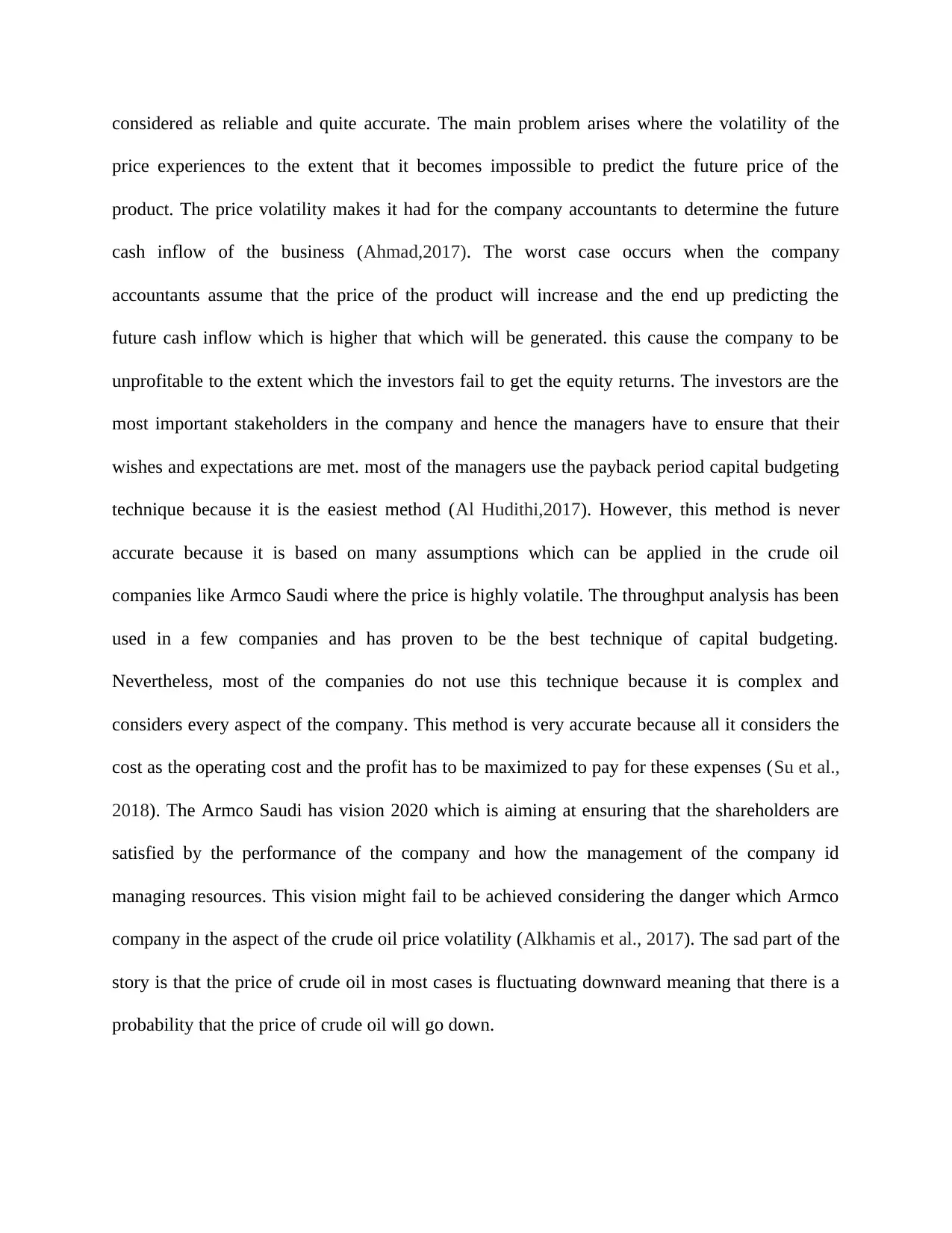
considered as reliable and quite accurate. The main problem arises where the volatility of the
price experiences to the extent that it becomes impossible to predict the future price of the
product. The price volatility makes it had for the company accountants to determine the future
cash inflow of the business (Ahmad,2017). The worst case occurs when the company
accountants assume that the price of the product will increase and the end up predicting the
future cash inflow which is higher that which will be generated. this cause the company to be
unprofitable to the extent which the investors fail to get the equity returns. The investors are the
most important stakeholders in the company and hence the managers have to ensure that their
wishes and expectations are met. most of the managers use the payback period capital budgeting
technique because it is the easiest method (Al Hudithi,2017). However, this method is never
accurate because it is based on many assumptions which can be applied in the crude oil
companies like Armco Saudi where the price is highly volatile. The throughput analysis has been
used in a few companies and has proven to be the best technique of capital budgeting.
Nevertheless, most of the companies do not use this technique because it is complex and
considers every aspect of the company. This method is very accurate because all it considers the
cost as the operating cost and the profit has to be maximized to pay for these expenses (Su et al.,
2018). The Armco Saudi has vision 2020 which is aiming at ensuring that the shareholders are
satisfied by the performance of the company and how the management of the company id
managing resources. This vision might fail to be achieved considering the danger which Armco
company in the aspect of the crude oil price volatility (Alkhamis et al., 2017). The sad part of the
story is that the price of crude oil in most cases is fluctuating downward meaning that there is a
probability that the price of crude oil will go down.
price experiences to the extent that it becomes impossible to predict the future price of the
product. The price volatility makes it had for the company accountants to determine the future
cash inflow of the business (Ahmad,2017). The worst case occurs when the company
accountants assume that the price of the product will increase and the end up predicting the
future cash inflow which is higher that which will be generated. this cause the company to be
unprofitable to the extent which the investors fail to get the equity returns. The investors are the
most important stakeholders in the company and hence the managers have to ensure that their
wishes and expectations are met. most of the managers use the payback period capital budgeting
technique because it is the easiest method (Al Hudithi,2017). However, this method is never
accurate because it is based on many assumptions which can be applied in the crude oil
companies like Armco Saudi where the price is highly volatile. The throughput analysis has been
used in a few companies and has proven to be the best technique of capital budgeting.
Nevertheless, most of the companies do not use this technique because it is complex and
considers every aspect of the company. This method is very accurate because all it considers the
cost as the operating cost and the profit has to be maximized to pay for these expenses (Su et al.,
2018). The Armco Saudi has vision 2020 which is aiming at ensuring that the shareholders are
satisfied by the performance of the company and how the management of the company id
managing resources. This vision might fail to be achieved considering the danger which Armco
company in the aspect of the crude oil price volatility (Alkhamis et al., 2017). The sad part of the
story is that the price of crude oil in most cases is fluctuating downward meaning that there is a
probability that the price of crude oil will go down.
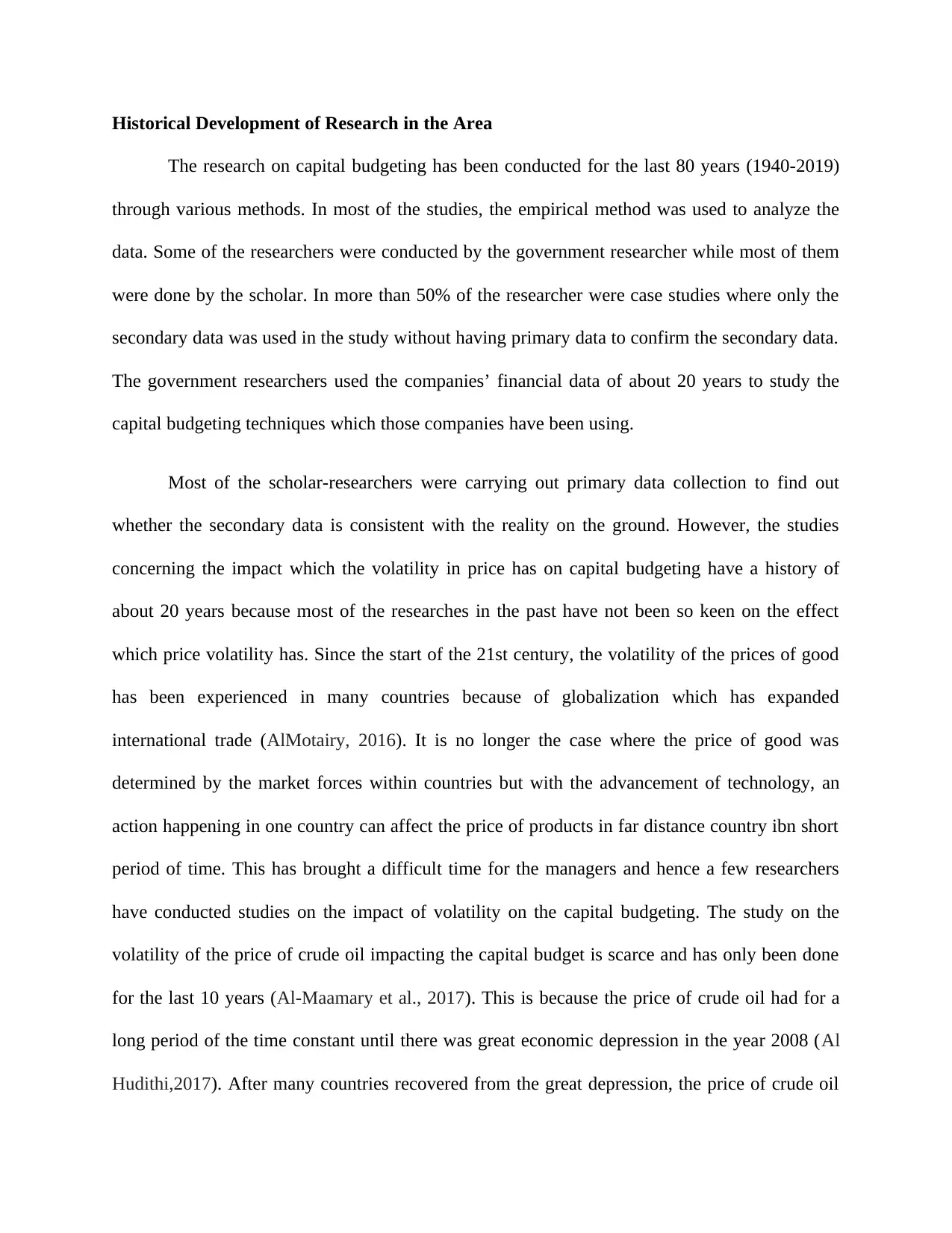
Historical Development of Research in the Area
The research on capital budgeting has been conducted for the last 80 years (1940-2019)
through various methods. In most of the studies, the empirical method was used to analyze the
data. Some of the researchers were conducted by the government researcher while most of them
were done by the scholar. In more than 50% of the researcher were case studies where only the
secondary data was used in the study without having primary data to confirm the secondary data.
The government researchers used the companies’ financial data of about 20 years to study the
capital budgeting techniques which those companies have been using.
Most of the scholar-researchers were carrying out primary data collection to find out
whether the secondary data is consistent with the reality on the ground. However, the studies
concerning the impact which the volatility in price has on capital budgeting have a history of
about 20 years because most of the researches in the past have not been so keen on the effect
which price volatility has. Since the start of the 21st century, the volatility of the prices of good
has been experienced in many countries because of globalization which has expanded
international trade (AlMotairy, 2016). It is no longer the case where the price of good was
determined by the market forces within countries but with the advancement of technology, an
action happening in one country can affect the price of products in far distance country ibn short
period of time. This has brought a difficult time for the managers and hence a few researchers
have conducted studies on the impact of volatility on the capital budgeting. The study on the
volatility of the price of crude oil impacting the capital budget is scarce and has only been done
for the last 10 years (Al-Maamary et al., 2017). This is because the price of crude oil had for a
long period of the time constant until there was great economic depression in the year 2008 (Al
Hudithi,2017). After many countries recovered from the great depression, the price of crude oil
The research on capital budgeting has been conducted for the last 80 years (1940-2019)
through various methods. In most of the studies, the empirical method was used to analyze the
data. Some of the researchers were conducted by the government researcher while most of them
were done by the scholar. In more than 50% of the researcher were case studies where only the
secondary data was used in the study without having primary data to confirm the secondary data.
The government researchers used the companies’ financial data of about 20 years to study the
capital budgeting techniques which those companies have been using.
Most of the scholar-researchers were carrying out primary data collection to find out
whether the secondary data is consistent with the reality on the ground. However, the studies
concerning the impact which the volatility in price has on capital budgeting have a history of
about 20 years because most of the researches in the past have not been so keen on the effect
which price volatility has. Since the start of the 21st century, the volatility of the prices of good
has been experienced in many countries because of globalization which has expanded
international trade (AlMotairy, 2016). It is no longer the case where the price of good was
determined by the market forces within countries but with the advancement of technology, an
action happening in one country can affect the price of products in far distance country ibn short
period of time. This has brought a difficult time for the managers and hence a few researchers
have conducted studies on the impact of volatility on the capital budgeting. The study on the
volatility of the price of crude oil impacting the capital budget is scarce and has only been done
for the last 10 years (Al-Maamary et al., 2017). This is because the price of crude oil had for a
long period of the time constant until there was great economic depression in the year 2008 (Al
Hudithi,2017). After many countries recovered from the great depression, the price of crude oil
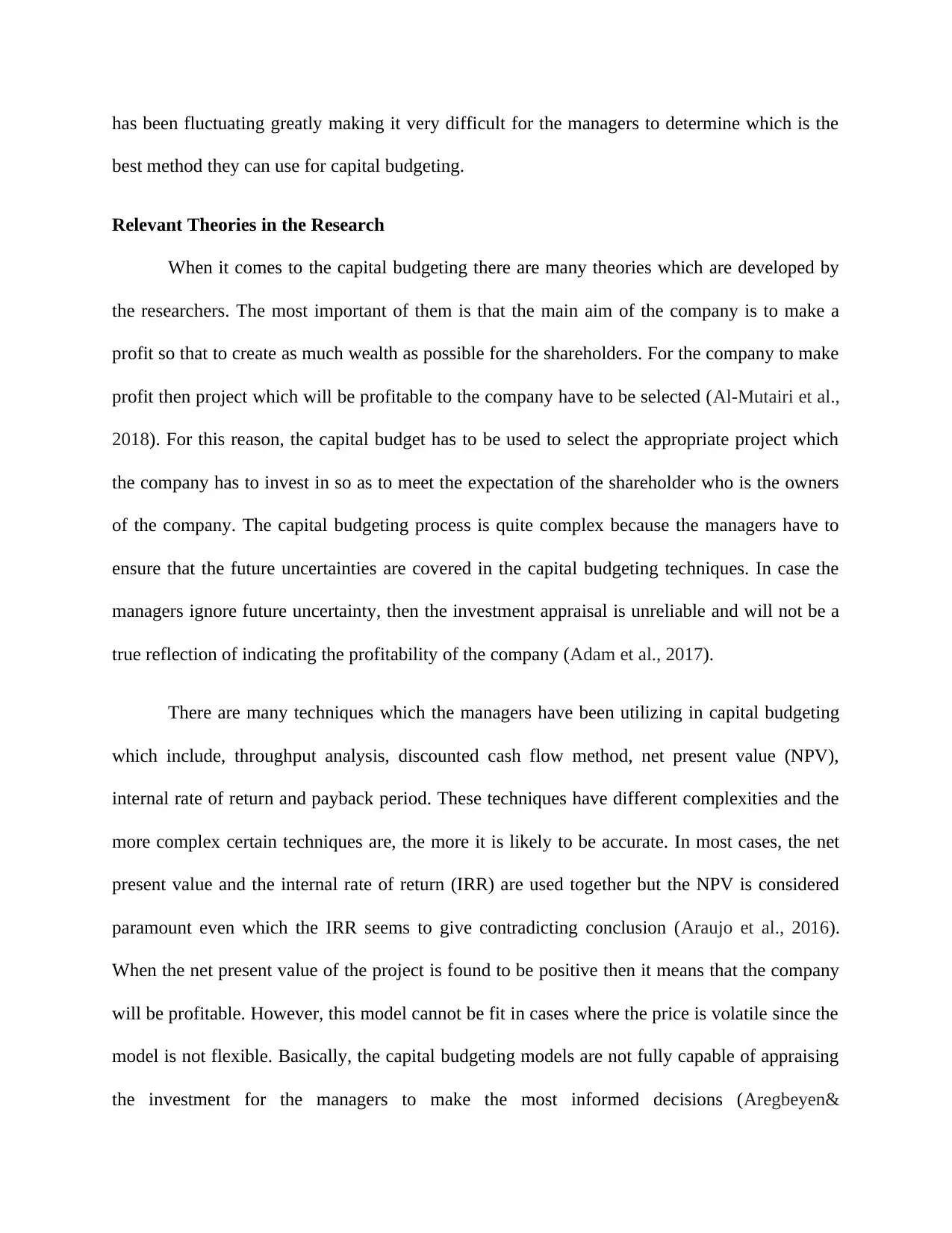
has been fluctuating greatly making it very difficult for the managers to determine which is the
best method they can use for capital budgeting.
Relevant Theories in the Research
When it comes to the capital budgeting there are many theories which are developed by
the researchers. The most important of them is that the main aim of the company is to make a
profit so that to create as much wealth as possible for the shareholders. For the company to make
profit then project which will be profitable to the company have to be selected (Al-Mutairi et al.,
2018). For this reason, the capital budget has to be used to select the appropriate project which
the company has to invest in so as to meet the expectation of the shareholder who is the owners
of the company. The capital budgeting process is quite complex because the managers have to
ensure that the future uncertainties are covered in the capital budgeting techniques. In case the
managers ignore future uncertainty, then the investment appraisal is unreliable and will not be a
true reflection of indicating the profitability of the company (Adam et al., 2017).
There are many techniques which the managers have been utilizing in capital budgeting
which include, throughput analysis, discounted cash flow method, net present value (NPV),
internal rate of return and payback period. These techniques have different complexities and the
more complex certain techniques are, the more it is likely to be accurate. In most cases, the net
present value and the internal rate of return (IRR) are used together but the NPV is considered
paramount even which the IRR seems to give contradicting conclusion (Araujo et al., 2016).
When the net present value of the project is found to be positive then it means that the company
will be profitable. However, this model cannot be fit in cases where the price is volatile since the
model is not flexible. Basically, the capital budgeting models are not fully capable of appraising
the investment for the managers to make the most informed decisions (Aregbeyen&
best method they can use for capital budgeting.
Relevant Theories in the Research
When it comes to the capital budgeting there are many theories which are developed by
the researchers. The most important of them is that the main aim of the company is to make a
profit so that to create as much wealth as possible for the shareholders. For the company to make
profit then project which will be profitable to the company have to be selected (Al-Mutairi et al.,
2018). For this reason, the capital budget has to be used to select the appropriate project which
the company has to invest in so as to meet the expectation of the shareholder who is the owners
of the company. The capital budgeting process is quite complex because the managers have to
ensure that the future uncertainties are covered in the capital budgeting techniques. In case the
managers ignore future uncertainty, then the investment appraisal is unreliable and will not be a
true reflection of indicating the profitability of the company (Adam et al., 2017).
There are many techniques which the managers have been utilizing in capital budgeting
which include, throughput analysis, discounted cash flow method, net present value (NPV),
internal rate of return and payback period. These techniques have different complexities and the
more complex certain techniques are, the more it is likely to be accurate. In most cases, the net
present value and the internal rate of return (IRR) are used together but the NPV is considered
paramount even which the IRR seems to give contradicting conclusion (Araujo et al., 2016).
When the net present value of the project is found to be positive then it means that the company
will be profitable. However, this model cannot be fit in cases where the price is volatile since the
model is not flexible. Basically, the capital budgeting models are not fully capable of appraising
the investment for the managers to make the most informed decisions (Aregbeyen&
Secure Best Marks with AI Grader
Need help grading? Try our AI Grader for instant feedback on your assignments.
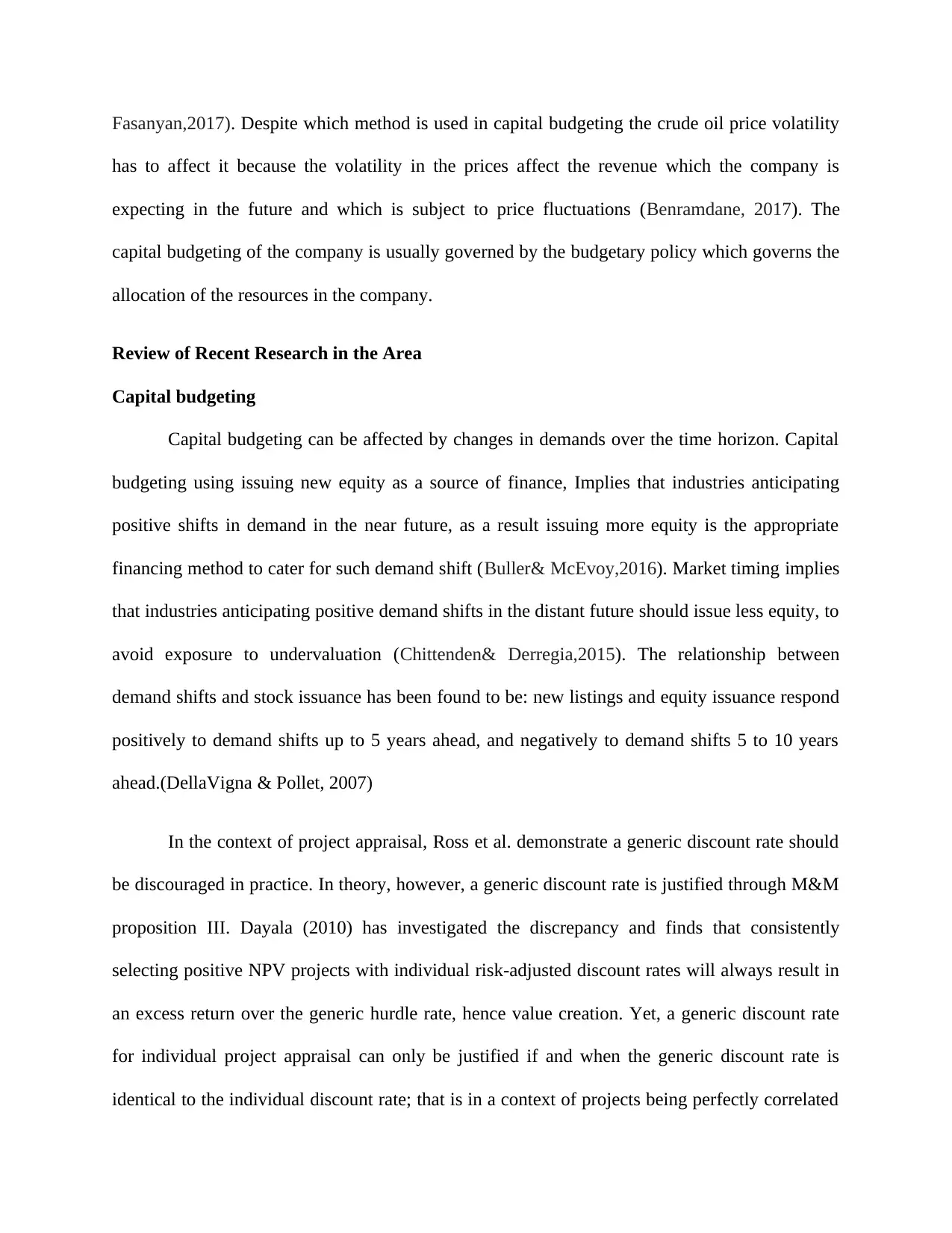
Fasanyan,2017). Despite which method is used in capital budgeting the crude oil price volatility
has to affect it because the volatility in the prices affect the revenue which the company is
expecting in the future and which is subject to price fluctuations (Benramdane, 2017). The
capital budgeting of the company is usually governed by the budgetary policy which governs the
allocation of the resources in the company.
Review of Recent Research in the Area
Capital budgeting
Capital budgeting can be affected by changes in demands over the time horizon. Capital
budgeting using issuing new equity as a source of finance, Implies that industries anticipating
positive shifts in demand in the near future, as a result issuing more equity is the appropriate
financing method to cater for such demand shift (Buller& McEvoy,2016). Market timing implies
that industries anticipating positive demand shifts in the distant future should issue less equity, to
avoid exposure to undervaluation (Chittenden& Derregia,2015). The relationship between
demand shifts and stock issuance has been found to be: new listings and equity issuance respond
positively to demand shifts up to 5 years ahead, and negatively to demand shifts 5 to 10 years
ahead.(DellaVigna & Pollet, 2007)
In the context of project appraisal, Ross et al. demonstrate a generic discount rate should
be discouraged in practice. In theory, however, a generic discount rate is justified through M&M
proposition III. Dayala (2010) has investigated the discrepancy and finds that consistently
selecting positive NPV projects with individual risk-adjusted discount rates will always result in
an excess return over the generic hurdle rate, hence value creation. Yet, a generic discount rate
for individual project appraisal can only be justified if and when the generic discount rate is
identical to the individual discount rate; that is in a context of projects being perfectly correlated
has to affect it because the volatility in the prices affect the revenue which the company is
expecting in the future and which is subject to price fluctuations (Benramdane, 2017). The
capital budgeting of the company is usually governed by the budgetary policy which governs the
allocation of the resources in the company.
Review of Recent Research in the Area
Capital budgeting
Capital budgeting can be affected by changes in demands over the time horizon. Capital
budgeting using issuing new equity as a source of finance, Implies that industries anticipating
positive shifts in demand in the near future, as a result issuing more equity is the appropriate
financing method to cater for such demand shift (Buller& McEvoy,2016). Market timing implies
that industries anticipating positive demand shifts in the distant future should issue less equity, to
avoid exposure to undervaluation (Chittenden& Derregia,2015). The relationship between
demand shifts and stock issuance has been found to be: new listings and equity issuance respond
positively to demand shifts up to 5 years ahead, and negatively to demand shifts 5 to 10 years
ahead.(DellaVigna & Pollet, 2007)
In the context of project appraisal, Ross et al. demonstrate a generic discount rate should
be discouraged in practice. In theory, however, a generic discount rate is justified through M&M
proposition III. Dayala (2010) has investigated the discrepancy and finds that consistently
selecting positive NPV projects with individual risk-adjusted discount rates will always result in
an excess return over the generic hurdle rate, hence value creation. Yet, a generic discount rate
for individual project appraisal can only be justified if and when the generic discount rate is
identical to the individual discount rate; that is in a context of projects being perfectly correlated
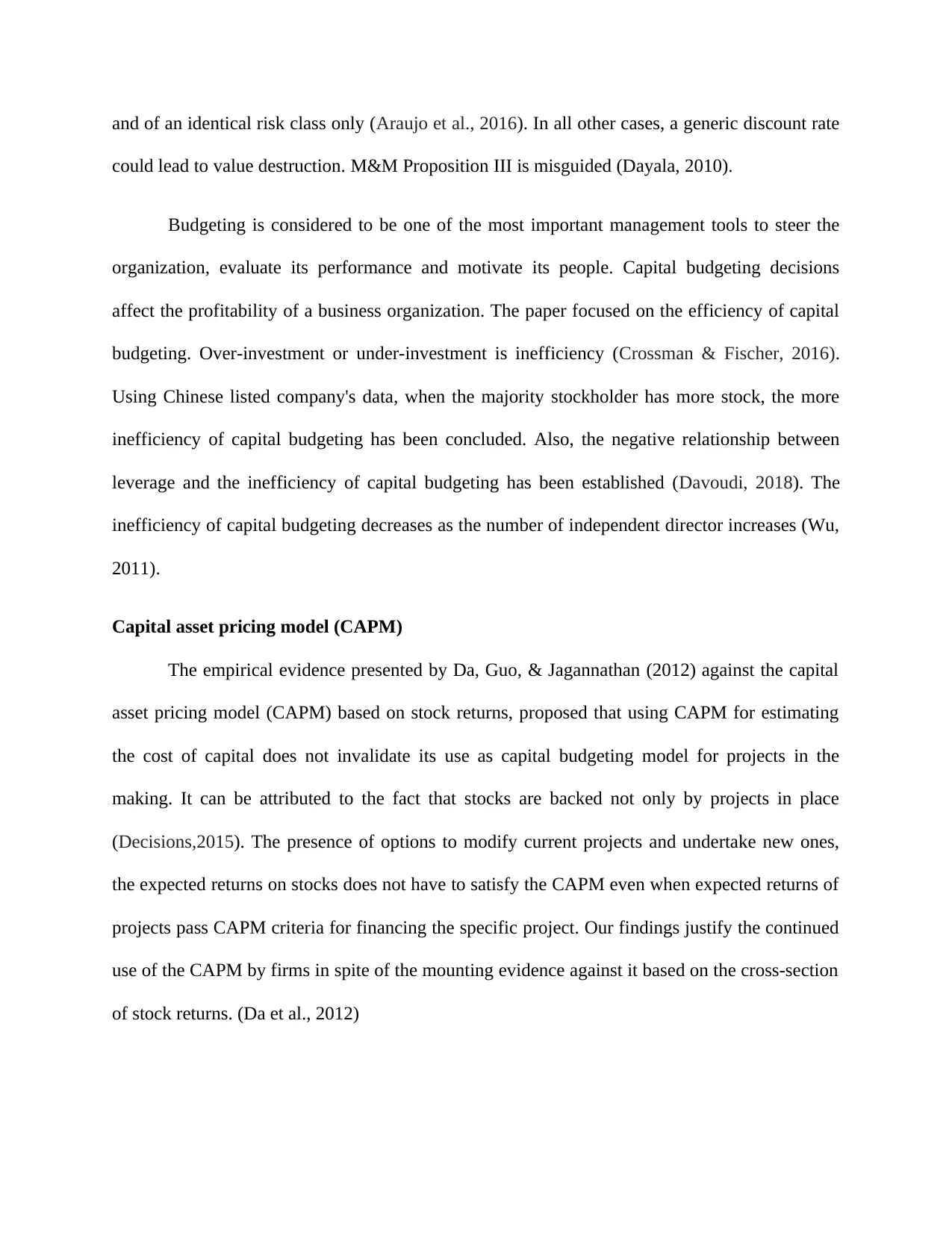
and of an identical risk class only (Araujo et al., 2016). In all other cases, a generic discount rate
could lead to value destruction. M&M Proposition III is misguided (Dayala, 2010).
Budgeting is considered to be one of the most important management tools to steer the
organization, evaluate its performance and motivate its people. Capital budgeting decisions
affect the profitability of a business organization. The paper focused on the efficiency of capital
budgeting. Over-investment or under-investment is inefficiency (Crossman & Fischer, 2016).
Using Chinese listed company's data, when the majority stockholder has more stock, the more
inefficiency of capital budgeting has been concluded. Also, the negative relationship between
leverage and the inefficiency of capital budgeting has been established (Davoudi, 2018). The
inefficiency of capital budgeting decreases as the number of independent director increases (Wu,
2011).
Capital asset pricing model (CAPM)
The empirical evidence presented by Da, Guo, & Jagannathan (2012) against the capital
asset pricing model (CAPM) based on stock returns, proposed that using CAPM for estimating
the cost of capital does not invalidate its use as capital budgeting model for projects in the
making. It can be attributed to the fact that stocks are backed not only by projects in place
(Decisions,2015). The presence of options to modify current projects and undertake new ones,
the expected returns on stocks does not have to satisfy the CAPM even when expected returns of
projects pass CAPM criteria for financing the specific project. Our findings justify the continued
use of the CAPM by firms in spite of the mounting evidence against it based on the cross-section
of stock returns. (Da et al., 2012)
could lead to value destruction. M&M Proposition III is misguided (Dayala, 2010).
Budgeting is considered to be one of the most important management tools to steer the
organization, evaluate its performance and motivate its people. Capital budgeting decisions
affect the profitability of a business organization. The paper focused on the efficiency of capital
budgeting. Over-investment or under-investment is inefficiency (Crossman & Fischer, 2016).
Using Chinese listed company's data, when the majority stockholder has more stock, the more
inefficiency of capital budgeting has been concluded. Also, the negative relationship between
leverage and the inefficiency of capital budgeting has been established (Davoudi, 2018). The
inefficiency of capital budgeting decreases as the number of independent director increases (Wu,
2011).
Capital asset pricing model (CAPM)
The empirical evidence presented by Da, Guo, & Jagannathan (2012) against the capital
asset pricing model (CAPM) based on stock returns, proposed that using CAPM for estimating
the cost of capital does not invalidate its use as capital budgeting model for projects in the
making. It can be attributed to the fact that stocks are backed not only by projects in place
(Decisions,2015). The presence of options to modify current projects and undertake new ones,
the expected returns on stocks does not have to satisfy the CAPM even when expected returns of
projects pass CAPM criteria for financing the specific project. Our findings justify the continued
use of the CAPM by firms in spite of the mounting evidence against it based on the cross-section
of stock returns. (Da et al., 2012)
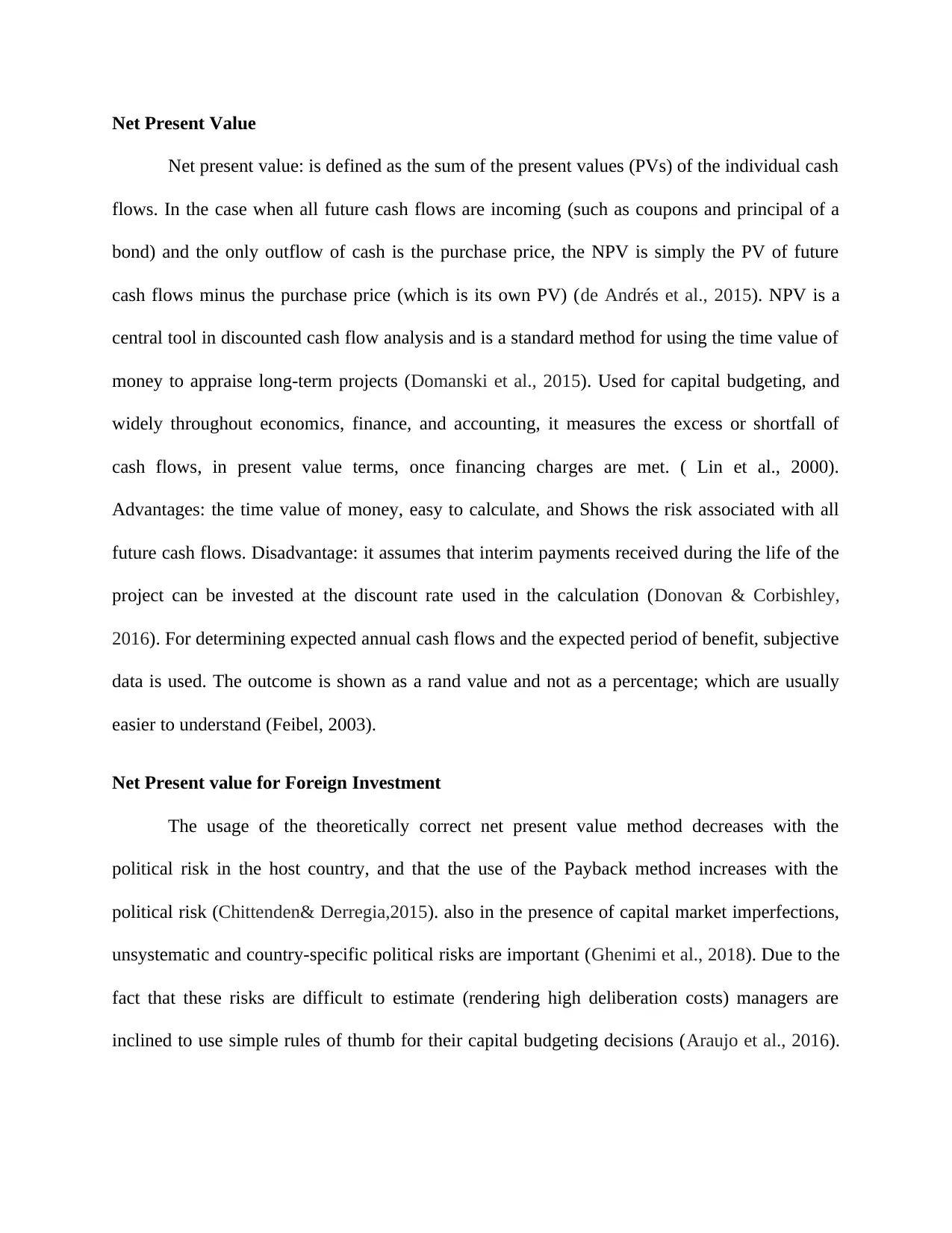
Net Present Value
Net present value: is defined as the sum of the present values (PVs) of the individual cash
flows. In the case when all future cash flows are incoming (such as coupons and principal of a
bond) and the only outflow of cash is the purchase price, the NPV is simply the PV of future
cash flows minus the purchase price (which is its own PV) (de Andrés et al., 2015). NPV is a
central tool in discounted cash flow analysis and is a standard method for using the time value of
money to appraise long-term projects (Domanski et al., 2015). Used for capital budgeting, and
widely throughout economics, finance, and accounting, it measures the excess or shortfall of
cash flows, in present value terms, once financing charges are met. ( Lin et al., 2000).
Advantages: the time value of money, easy to calculate, and Shows the risk associated with all
future cash flows. Disadvantage: it assumes that interim payments received during the life of the
project can be invested at the discount rate used in the calculation (Donovan & Corbishley,
2016). For determining expected annual cash flows and the expected period of benefit, subjective
data is used. The outcome is shown as a rand value and not as a percentage; which are usually
easier to understand (Feibel, 2003).
Net Present value for Foreign Investment
The usage of the theoretically correct net present value method decreases with the
political risk in the host country, and that the use of the Payback method increases with the
political risk (Chittenden& Derregia,2015). also in the presence of capital market imperfections,
unsystematic and country-specific political risks are important (Ghenimi et al., 2018). Due to the
fact that these risks are difficult to estimate (rendering high deliberation costs) managers are
inclined to use simple rules of thumb for their capital budgeting decisions (Araujo et al., 2016).
Net present value: is defined as the sum of the present values (PVs) of the individual cash
flows. In the case when all future cash flows are incoming (such as coupons and principal of a
bond) and the only outflow of cash is the purchase price, the NPV is simply the PV of future
cash flows minus the purchase price (which is its own PV) (de Andrés et al., 2015). NPV is a
central tool in discounted cash flow analysis and is a standard method for using the time value of
money to appraise long-term projects (Domanski et al., 2015). Used for capital budgeting, and
widely throughout economics, finance, and accounting, it measures the excess or shortfall of
cash flows, in present value terms, once financing charges are met. ( Lin et al., 2000).
Advantages: the time value of money, easy to calculate, and Shows the risk associated with all
future cash flows. Disadvantage: it assumes that interim payments received during the life of the
project can be invested at the discount rate used in the calculation (Donovan & Corbishley,
2016). For determining expected annual cash flows and the expected period of benefit, subjective
data is used. The outcome is shown as a rand value and not as a percentage; which are usually
easier to understand (Feibel, 2003).
Net Present value for Foreign Investment
The usage of the theoretically correct net present value method decreases with the
political risk in the host country, and that the use of the Payback method increases with the
political risk (Chittenden& Derregia,2015). also in the presence of capital market imperfections,
unsystematic and country-specific political risks are important (Ghenimi et al., 2018). Due to the
fact that these risks are difficult to estimate (rendering high deliberation costs) managers are
inclined to use simple rules of thumb for their capital budgeting decisions (Araujo et al., 2016).
Paraphrase This Document
Need a fresh take? Get an instant paraphrase of this document with our AI Paraphraser
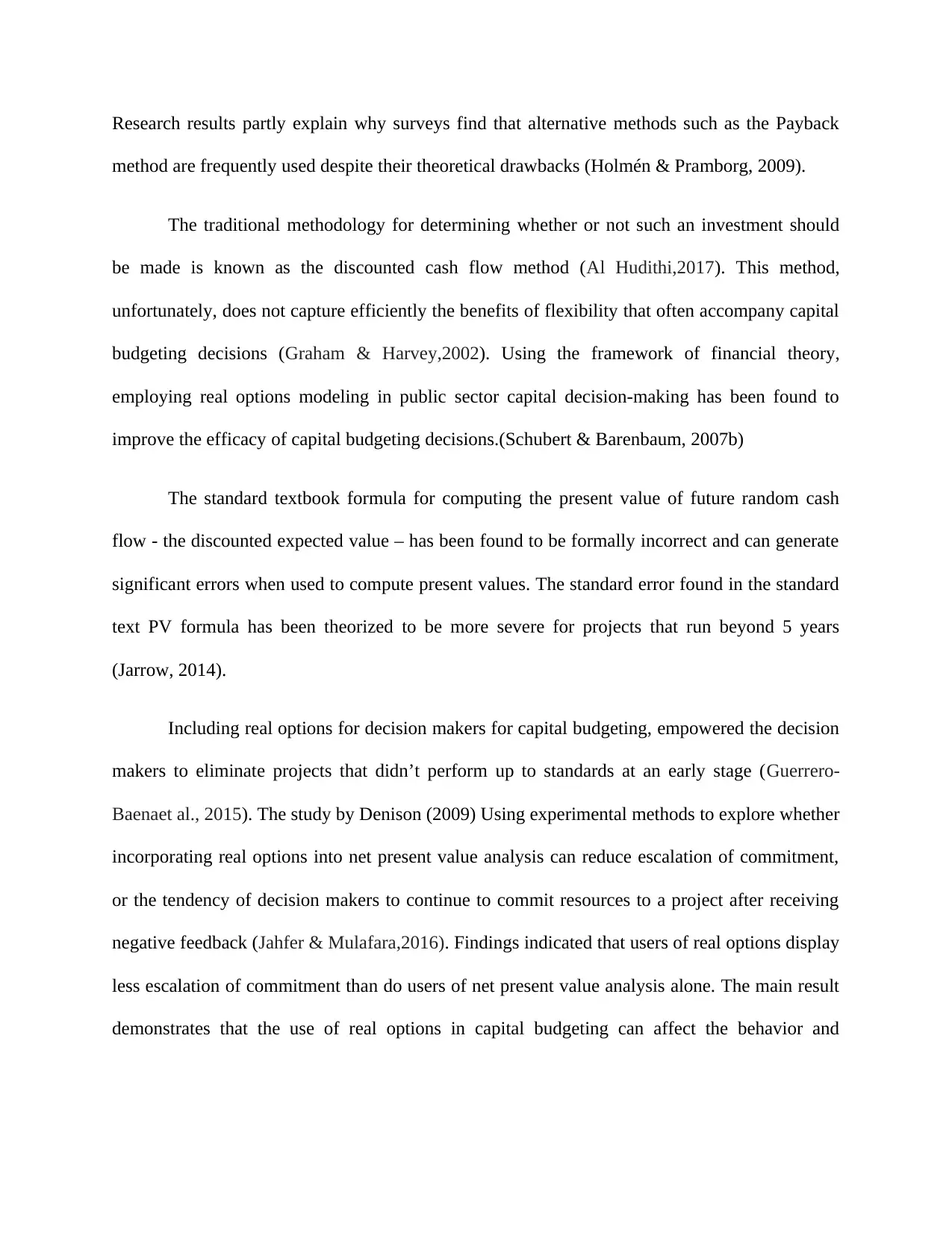
Research results partly explain why surveys find that alternative methods such as the Payback
method are frequently used despite their theoretical drawbacks (Holmén & Pramborg, 2009).
The traditional methodology for determining whether or not such an investment should
be made is known as the discounted cash flow method (Al Hudithi,2017). This method,
unfortunately, does not capture efficiently the benefits of flexibility that often accompany capital
budgeting decisions (Graham & Harvey,2002). Using the framework of financial theory,
employing real options modeling in public sector capital decision-making has been found to
improve the efficacy of capital budgeting decisions.(Schubert & Barenbaum, 2007b)
The standard textbook formula for computing the present value of future random cash
flow - the discounted expected value – has been found to be formally incorrect and can generate
significant errors when used to compute present values. The standard error found in the standard
text PV formula has been theorized to be more severe for projects that run beyond 5 years
(Jarrow, 2014).
Including real options for decision makers for capital budgeting, empowered the decision
makers to eliminate projects that didn’t perform up to standards at an early stage (Guerrero-
Baenaet al., 2015). The study by Denison (2009) Using experimental methods to explore whether
incorporating real options into net present value analysis can reduce escalation of commitment,
or the tendency of decision makers to continue to commit resources to a project after receiving
negative feedback (Jahfer & Mulafara,2016). Findings indicated that users of real options display
less escalation of commitment than do users of net present value analysis alone. The main result
demonstrates that the use of real options in capital budgeting can affect the behavior and
method are frequently used despite their theoretical drawbacks (Holmén & Pramborg, 2009).
The traditional methodology for determining whether or not such an investment should
be made is known as the discounted cash flow method (Al Hudithi,2017). This method,
unfortunately, does not capture efficiently the benefits of flexibility that often accompany capital
budgeting decisions (Graham & Harvey,2002). Using the framework of financial theory,
employing real options modeling in public sector capital decision-making has been found to
improve the efficacy of capital budgeting decisions.(Schubert & Barenbaum, 2007b)
The standard textbook formula for computing the present value of future random cash
flow - the discounted expected value – has been found to be formally incorrect and can generate
significant errors when used to compute present values. The standard error found in the standard
text PV formula has been theorized to be more severe for projects that run beyond 5 years
(Jarrow, 2014).
Including real options for decision makers for capital budgeting, empowered the decision
makers to eliminate projects that didn’t perform up to standards at an early stage (Guerrero-
Baenaet al., 2015). The study by Denison (2009) Using experimental methods to explore whether
incorporating real options into net present value analysis can reduce escalation of commitment,
or the tendency of decision makers to continue to commit resources to a project after receiving
negative feedback (Jahfer & Mulafara,2016). Findings indicated that users of real options display
less escalation of commitment than do users of net present value analysis alone. The main result
demonstrates that the use of real options in capital budgeting can affect the behavior and
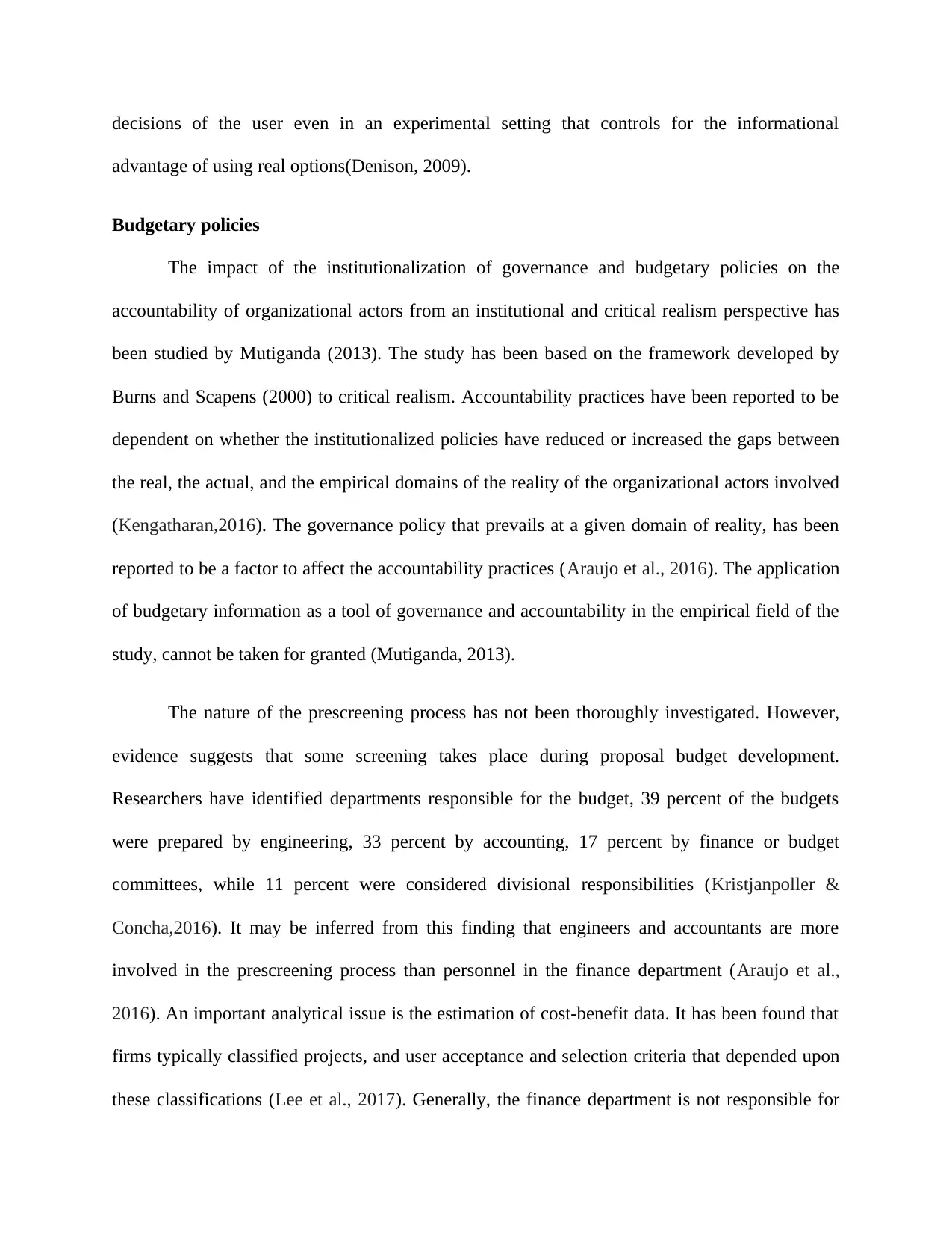
decisions of the user even in an experimental setting that controls for the informational
advantage of using real options(Denison, 2009).
Budgetary policies
The impact of the institutionalization of governance and budgetary policies on the
accountability of organizational actors from an institutional and critical realism perspective has
been studied by Mutiganda (2013). The study has been based on the framework developed by
Burns and Scapens (2000) to critical realism. Accountability practices have been reported to be
dependent on whether the institutionalized policies have reduced or increased the gaps between
the real, the actual, and the empirical domains of the reality of the organizational actors involved
(Kengatharan,2016). The governance policy that prevails at a given domain of reality, has been
reported to be a factor to affect the accountability practices (Araujo et al., 2016). The application
of budgetary information as a tool of governance and accountability in the empirical field of the
study, cannot be taken for granted (Mutiganda, 2013).
The nature of the prescreening process has not been thoroughly investigated. However,
evidence suggests that some screening takes place during proposal budget development.
Researchers have identified departments responsible for the budget, 39 percent of the budgets
were prepared by engineering, 33 percent by accounting, 17 percent by finance or budget
committees, while 11 percent were considered divisional responsibilities (Kristjanpoller &
Concha,2016). It may be inferred from this finding that engineers and accountants are more
involved in the prescreening process than personnel in the finance department (Araujo et al.,
2016). An important analytical issue is the estimation of cost-benefit data. It has been found that
firms typically classified projects, and user acceptance and selection criteria that depended upon
these classifications (Lee et al., 2017). Generally, the finance department is not responsible for
advantage of using real options(Denison, 2009).
Budgetary policies
The impact of the institutionalization of governance and budgetary policies on the
accountability of organizational actors from an institutional and critical realism perspective has
been studied by Mutiganda (2013). The study has been based on the framework developed by
Burns and Scapens (2000) to critical realism. Accountability practices have been reported to be
dependent on whether the institutionalized policies have reduced or increased the gaps between
the real, the actual, and the empirical domains of the reality of the organizational actors involved
(Kengatharan,2016). The governance policy that prevails at a given domain of reality, has been
reported to be a factor to affect the accountability practices (Araujo et al., 2016). The application
of budgetary information as a tool of governance and accountability in the empirical field of the
study, cannot be taken for granted (Mutiganda, 2013).
The nature of the prescreening process has not been thoroughly investigated. However,
evidence suggests that some screening takes place during proposal budget development.
Researchers have identified departments responsible for the budget, 39 percent of the budgets
were prepared by engineering, 33 percent by accounting, 17 percent by finance or budget
committees, while 11 percent were considered divisional responsibilities (Kristjanpoller &
Concha,2016). It may be inferred from this finding that engineers and accountants are more
involved in the prescreening process than personnel in the finance department (Araujo et al.,
2016). An important analytical issue is the estimation of cost-benefit data. It has been found that
firms typically classified projects, and user acceptance and selection criteria that depended upon
these classifications (Lee et al., 2017). Generally, the finance department is not responsible for
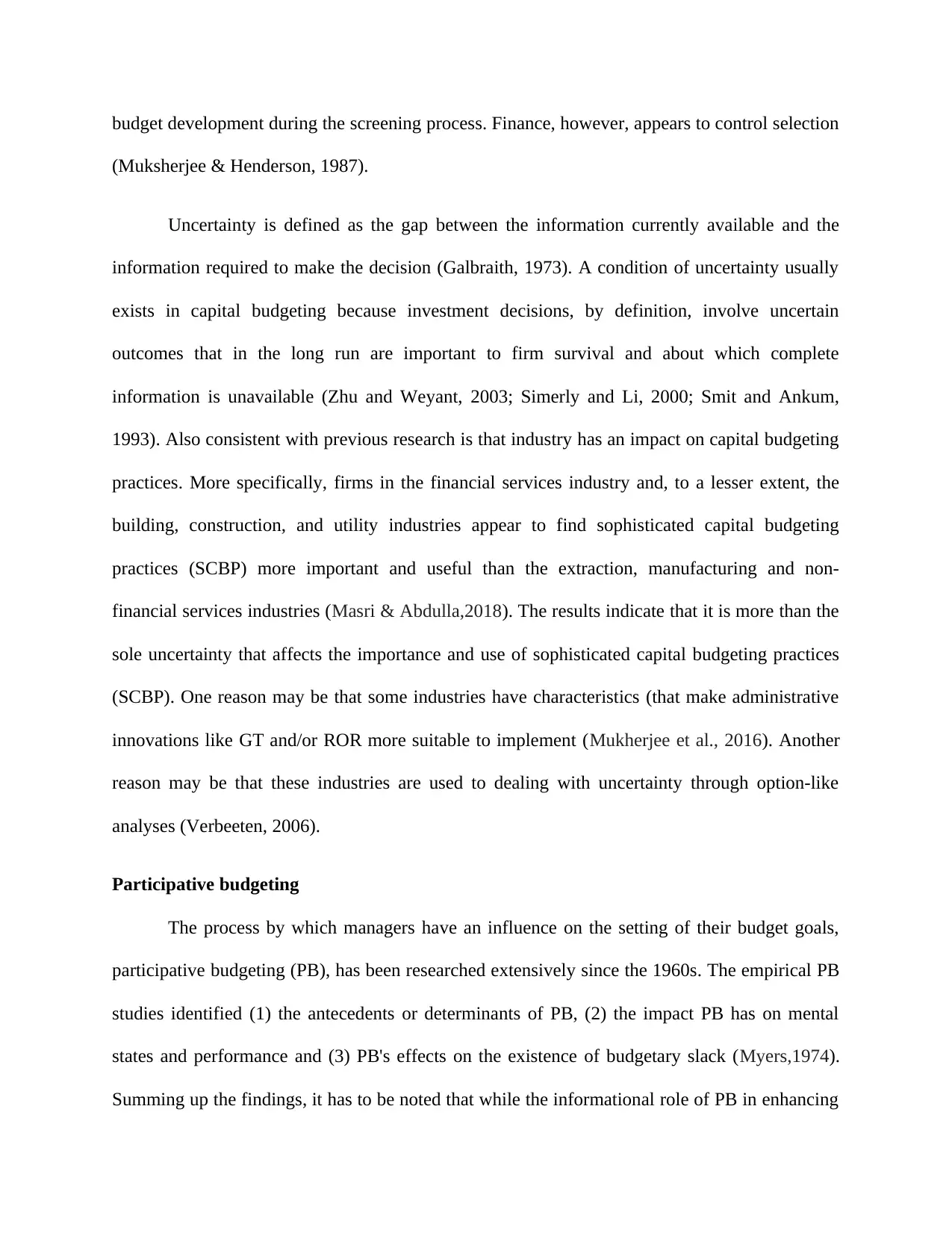
budget development during the screening process. Finance, however, appears to control selection
(Muksherjee & Henderson, 1987).
Uncertainty is defined as the gap between the information currently available and the
information required to make the decision (Galbraith, 1973). A condition of uncertainty usually
exists in capital budgeting because investment decisions, by definition, involve uncertain
outcomes that in the long run are important to firm survival and about which complete
information is unavailable (Zhu and Weyant, 2003; Simerly and Li, 2000; Smit and Ankum,
1993). Also consistent with previous research is that industry has an impact on capital budgeting
practices. More specifically, firms in the financial services industry and, to a lesser extent, the
building, construction, and utility industries appear to find sophisticated capital budgeting
practices (SCBP) more important and useful than the extraction, manufacturing and non-
financial services industries (Masri & Abdulla,2018). The results indicate that it is more than the
sole uncertainty that affects the importance and use of sophisticated capital budgeting practices
(SCBP). One reason may be that some industries have characteristics (that make administrative
innovations like GT and/or ROR more suitable to implement (Mukherjee et al., 2016). Another
reason may be that these industries are used to dealing with uncertainty through option-like
analyses (Verbeeten, 2006).
Participative budgeting
The process by which managers have an influence on the setting of their budget goals,
participative budgeting (PB), has been researched extensively since the 1960s. The empirical PB
studies identified (1) the antecedents or determinants of PB, (2) the impact PB has on mental
states and performance and (3) PB's effects on the existence of budgetary slack (Myers,1974).
Summing up the findings, it has to be noted that while the informational role of PB in enhancing
(Muksherjee & Henderson, 1987).
Uncertainty is defined as the gap between the information currently available and the
information required to make the decision (Galbraith, 1973). A condition of uncertainty usually
exists in capital budgeting because investment decisions, by definition, involve uncertain
outcomes that in the long run are important to firm survival and about which complete
information is unavailable (Zhu and Weyant, 2003; Simerly and Li, 2000; Smit and Ankum,
1993). Also consistent with previous research is that industry has an impact on capital budgeting
practices. More specifically, firms in the financial services industry and, to a lesser extent, the
building, construction, and utility industries appear to find sophisticated capital budgeting
practices (SCBP) more important and useful than the extraction, manufacturing and non-
financial services industries (Masri & Abdulla,2018). The results indicate that it is more than the
sole uncertainty that affects the importance and use of sophisticated capital budgeting practices
(SCBP). One reason may be that some industries have characteristics (that make administrative
innovations like GT and/or ROR more suitable to implement (Mukherjee et al., 2016). Another
reason may be that these industries are used to dealing with uncertainty through option-like
analyses (Verbeeten, 2006).
Participative budgeting
The process by which managers have an influence on the setting of their budget goals,
participative budgeting (PB), has been researched extensively since the 1960s. The empirical PB
studies identified (1) the antecedents or determinants of PB, (2) the impact PB has on mental
states and performance and (3) PB's effects on the existence of budgetary slack (Myers,1974).
Summing up the findings, it has to be noted that while the informational role of PB in enhancing
Secure Best Marks with AI Grader
Need help grading? Try our AI Grader for instant feedback on your assignments.
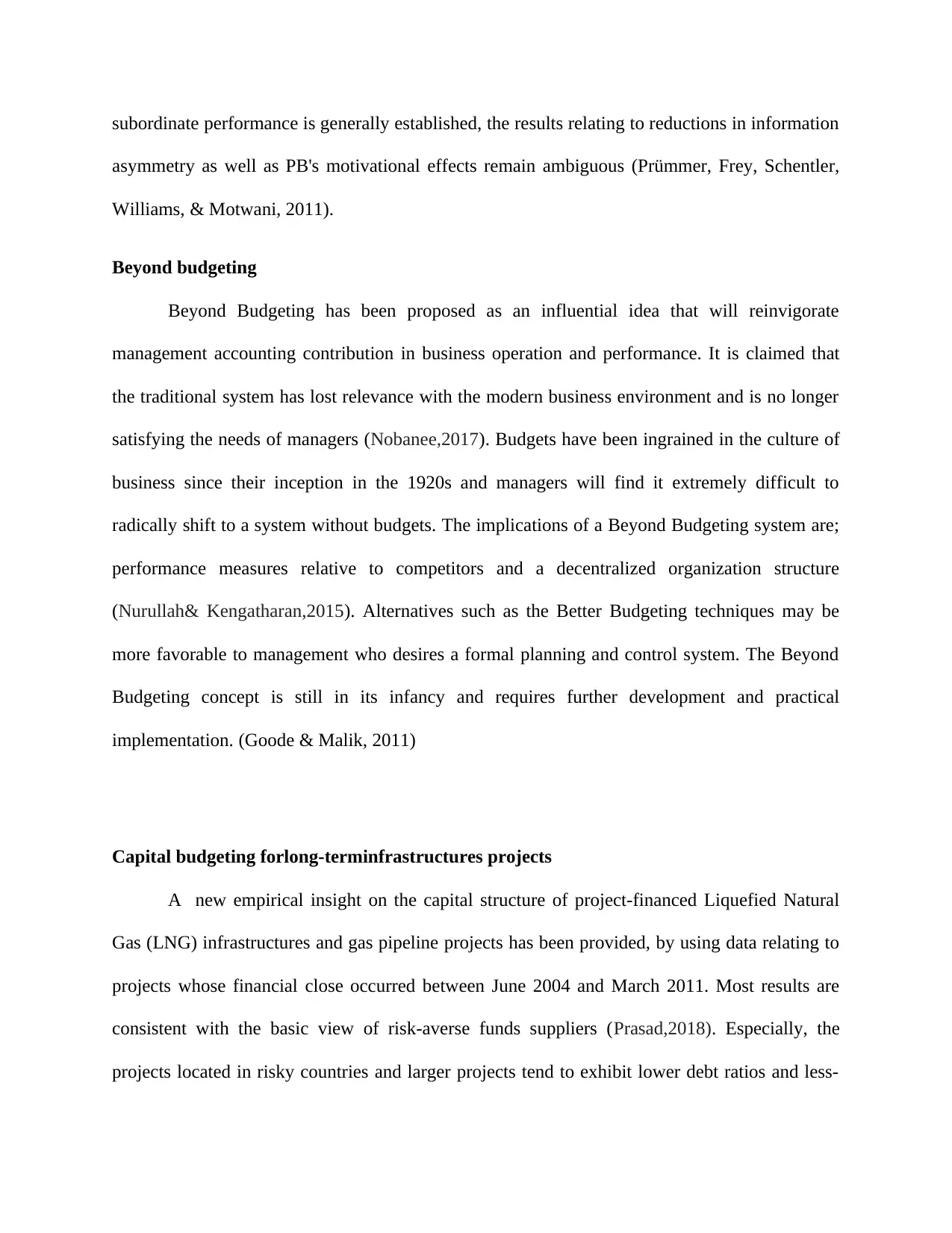
subordinate performance is generally established, the results relating to reductions in information
asymmetry as well as PB's motivational effects remain ambiguous (Prümmer, Frey, Schentler,
Williams, & Motwani, 2011).
Beyond budgeting
Beyond Budgeting has been proposed as an influential idea that will reinvigorate
management accounting contribution in business operation and performance. It is claimed that
the traditional system has lost relevance with the modern business environment and is no longer
satisfying the needs of managers (Nobanee,2017). Budgets have been ingrained in the culture of
business since their inception in the 1920s and managers will find it extremely difficult to
radically shift to a system without budgets. The implications of a Beyond Budgeting system are;
performance measures relative to competitors and a decentralized organization structure
(Nurullah& Kengatharan,2015). Alternatives such as the Better Budgeting techniques may be
more favorable to management who desires a formal planning and control system. The Beyond
Budgeting concept is still in its infancy and requires further development and practical
implementation. (Goode & Malik, 2011)
Capital budgeting forlong-terminfrastructures projects
A new empirical insight on the capital structure of project-financed Liquefied Natural
Gas (LNG) infrastructures and gas pipeline projects has been provided, by using data relating to
projects whose financial close occurred between June 2004 and March 2011. Most results are
consistent with the basic view of risk-averse funds suppliers (Prasad,2018). Especially, the
projects located in risky countries and larger projects tend to exhibit lower debt ratios and less-
asymmetry as well as PB's motivational effects remain ambiguous (Prümmer, Frey, Schentler,
Williams, & Motwani, 2011).
Beyond budgeting
Beyond Budgeting has been proposed as an influential idea that will reinvigorate
management accounting contribution in business operation and performance. It is claimed that
the traditional system has lost relevance with the modern business environment and is no longer
satisfying the needs of managers (Nobanee,2017). Budgets have been ingrained in the culture of
business since their inception in the 1920s and managers will find it extremely difficult to
radically shift to a system without budgets. The implications of a Beyond Budgeting system are;
performance measures relative to competitors and a decentralized organization structure
(Nurullah& Kengatharan,2015). Alternatives such as the Better Budgeting techniques may be
more favorable to management who desires a formal planning and control system. The Beyond
Budgeting concept is still in its infancy and requires further development and practical
implementation. (Goode & Malik, 2011)
Capital budgeting forlong-terminfrastructures projects
A new empirical insight on the capital structure of project-financed Liquefied Natural
Gas (LNG) infrastructures and gas pipeline projects has been provided, by using data relating to
projects whose financial close occurred between June 2004 and March 2011. Most results are
consistent with the basic view of risk-averse funds suppliers (Prasad,2018). Especially, the
projects located in risky countries and larger projects tend to exhibit lower debt ratios and less-
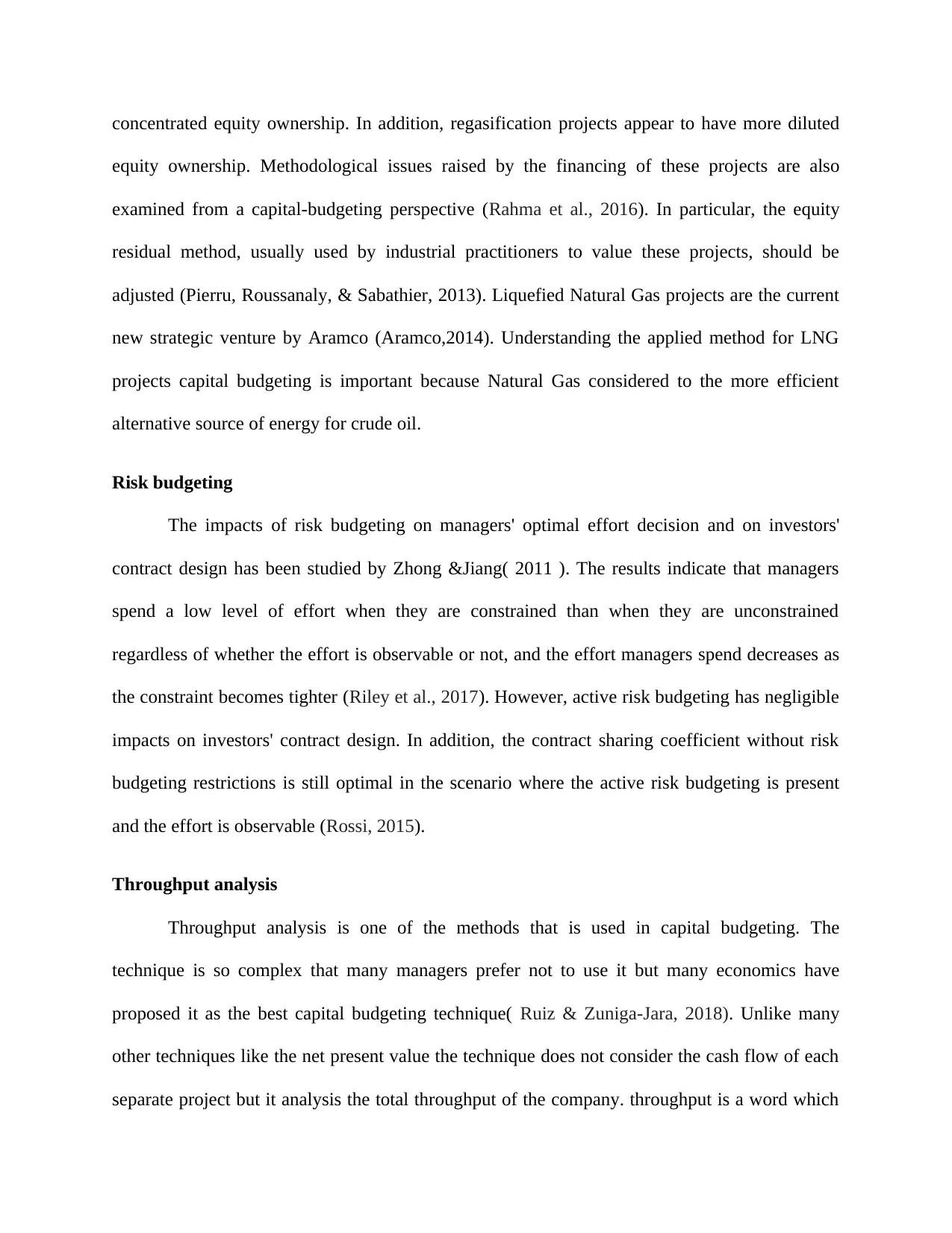
concentrated equity ownership. In addition, regasification projects appear to have more diluted
equity ownership. Methodological issues raised by the financing of these projects are also
examined from a capital-budgeting perspective (Rahma et al., 2016). In particular, the equity
residual method, usually used by industrial practitioners to value these projects, should be
adjusted (Pierru, Roussanaly, & Sabathier, 2013). Liquefied Natural Gas projects are the current
new strategic venture by Aramco (Aramco,2014). Understanding the applied method for LNG
projects capital budgeting is important because Natural Gas considered to the more efficient
alternative source of energy for crude oil.
Risk budgeting
The impacts of risk budgeting on managers' optimal effort decision and on investors'
contract design has been studied by Zhong &Jiang( 2011 ). The results indicate that managers
spend a low level of effort when they are constrained than when they are unconstrained
regardless of whether the effort is observable or not, and the effort managers spend decreases as
the constraint becomes tighter (Riley et al., 2017). However, active risk budgeting has negligible
impacts on investors' contract design. In addition, the contract sharing coefficient without risk
budgeting restrictions is still optimal in the scenario where the active risk budgeting is present
and the effort is observable (Rossi, 2015).
Throughput analysis
Throughput analysis is one of the methods that is used in capital budgeting. The
technique is so complex that many managers prefer not to use it but many economics have
proposed it as the best capital budgeting technique( Ruiz & Zuniga-Jara, 2018). Unlike many
other techniques like the net present value the technique does not consider the cash flow of each
separate project but it analysis the total throughput of the company. throughput is a word which
equity ownership. Methodological issues raised by the financing of these projects are also
examined from a capital-budgeting perspective (Rahma et al., 2016). In particular, the equity
residual method, usually used by industrial practitioners to value these projects, should be
adjusted (Pierru, Roussanaly, & Sabathier, 2013). Liquefied Natural Gas projects are the current
new strategic venture by Aramco (Aramco,2014). Understanding the applied method for LNG
projects capital budgeting is important because Natural Gas considered to the more efficient
alternative source of energy for crude oil.
Risk budgeting
The impacts of risk budgeting on managers' optimal effort decision and on investors'
contract design has been studied by Zhong &Jiang( 2011 ). The results indicate that managers
spend a low level of effort when they are constrained than when they are unconstrained
regardless of whether the effort is observable or not, and the effort managers spend decreases as
the constraint becomes tighter (Riley et al., 2017). However, active risk budgeting has negligible
impacts on investors' contract design. In addition, the contract sharing coefficient without risk
budgeting restrictions is still optimal in the scenario where the active risk budgeting is present
and the effort is observable (Rossi, 2015).
Throughput analysis
Throughput analysis is one of the methods that is used in capital budgeting. The
technique is so complex that many managers prefer not to use it but many economics have
proposed it as the best capital budgeting technique( Ruiz & Zuniga-Jara, 2018). Unlike many
other techniques like the net present value the technique does not consider the cash flow of each
separate project but it analysis the total throughput of the company. throughput is a word which
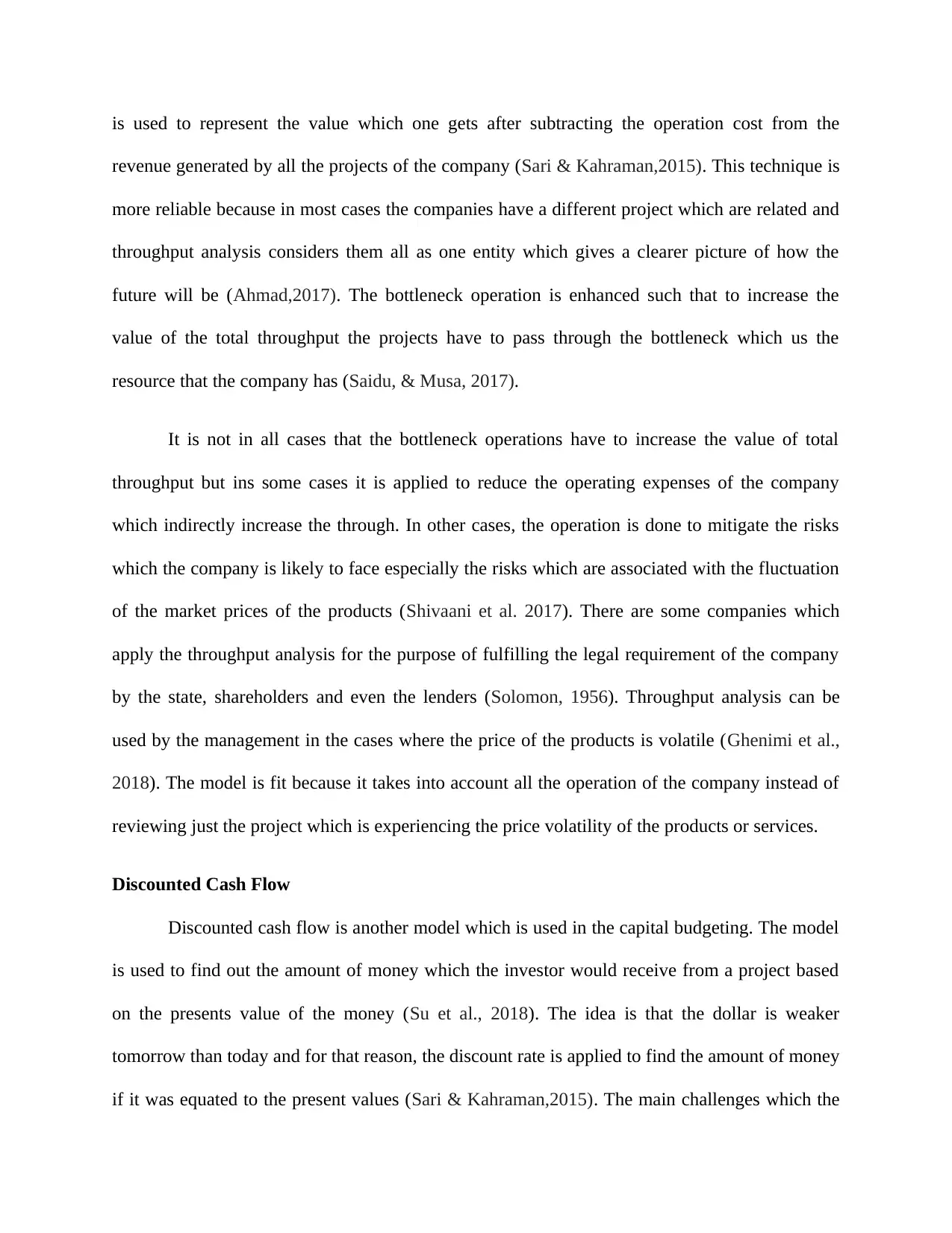
is used to represent the value which one gets after subtracting the operation cost from the
revenue generated by all the projects of the company (Sari & Kahraman,2015). This technique is
more reliable because in most cases the companies have a different project which are related and
throughput analysis considers them all as one entity which gives a clearer picture of how the
future will be (Ahmad,2017). The bottleneck operation is enhanced such that to increase the
value of the total throughput the projects have to pass through the bottleneck which us the
resource that the company has (Saidu, & Musa, 2017).
It is not in all cases that the bottleneck operations have to increase the value of total
throughput but ins some cases it is applied to reduce the operating expenses of the company
which indirectly increase the through. In other cases, the operation is done to mitigate the risks
which the company is likely to face especially the risks which are associated with the fluctuation
of the market prices of the products (Shivaani et al. 2017). There are some companies which
apply the throughput analysis for the purpose of fulfilling the legal requirement of the company
by the state, shareholders and even the lenders (Solomon, 1956). Throughput analysis can be
used by the management in the cases where the price of the products is volatile (Ghenimi et al.,
2018). The model is fit because it takes into account all the operation of the company instead of
reviewing just the project which is experiencing the price volatility of the products or services.
Discounted Cash Flow
Discounted cash flow is another model which is used in the capital budgeting. The model
is used to find out the amount of money which the investor would receive from a project based
on the presents value of the money (Su et al., 2018). The idea is that the dollar is weaker
tomorrow than today and for that reason, the discount rate is applied to find the amount of money
if it was equated to the present values (Sari & Kahraman,2015). The main challenges which the
revenue generated by all the projects of the company (Sari & Kahraman,2015). This technique is
more reliable because in most cases the companies have a different project which are related and
throughput analysis considers them all as one entity which gives a clearer picture of how the
future will be (Ahmad,2017). The bottleneck operation is enhanced such that to increase the
value of the total throughput the projects have to pass through the bottleneck which us the
resource that the company has (Saidu, & Musa, 2017).
It is not in all cases that the bottleneck operations have to increase the value of total
throughput but ins some cases it is applied to reduce the operating expenses of the company
which indirectly increase the through. In other cases, the operation is done to mitigate the risks
which the company is likely to face especially the risks which are associated with the fluctuation
of the market prices of the products (Shivaani et al. 2017). There are some companies which
apply the throughput analysis for the purpose of fulfilling the legal requirement of the company
by the state, shareholders and even the lenders (Solomon, 1956). Throughput analysis can be
used by the management in the cases where the price of the products is volatile (Ghenimi et al.,
2018). The model is fit because it takes into account all the operation of the company instead of
reviewing just the project which is experiencing the price volatility of the products or services.
Discounted Cash Flow
Discounted cash flow is another model which is used in the capital budgeting. The model
is used to find out the amount of money which the investor would receive from a project based
on the presents value of the money (Su et al., 2018). The idea is that the dollar is weaker
tomorrow than today and for that reason, the discount rate is applied to find the amount of money
if it was equated to the present values (Sari & Kahraman,2015). The main challenges which the
Paraphrase This Document
Need a fresh take? Get an instant paraphrase of this document with our AI Paraphraser
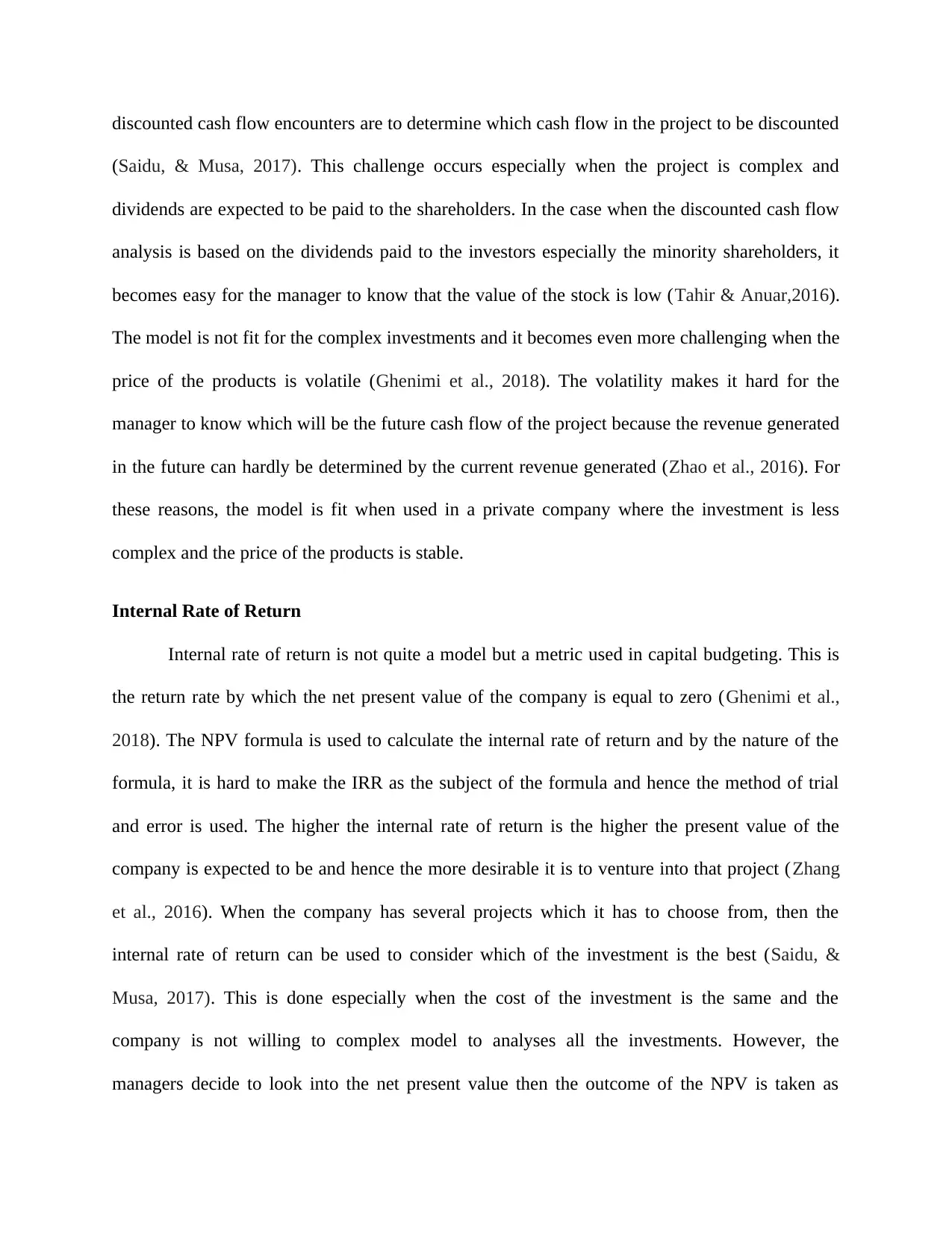
discounted cash flow encounters are to determine which cash flow in the project to be discounted
(Saidu, & Musa, 2017). This challenge occurs especially when the project is complex and
dividends are expected to be paid to the shareholders. In the case when the discounted cash flow
analysis is based on the dividends paid to the investors especially the minority shareholders, it
becomes easy for the manager to know that the value of the stock is low (Tahir & Anuar,2016).
The model is not fit for the complex investments and it becomes even more challenging when the
price of the products is volatile (Ghenimi et al., 2018). The volatility makes it hard for the
manager to know which will be the future cash flow of the project because the revenue generated
in the future can hardly be determined by the current revenue generated (Zhao et al., 2016). For
these reasons, the model is fit when used in a private company where the investment is less
complex and the price of the products is stable.
Internal Rate of Return
Internal rate of return is not quite a model but a metric used in capital budgeting. This is
the return rate by which the net present value of the company is equal to zero (Ghenimi et al.,
2018). The NPV formula is used to calculate the internal rate of return and by the nature of the
formula, it is hard to make the IRR as the subject of the formula and hence the method of trial
and error is used. The higher the internal rate of return is the higher the present value of the
company is expected to be and hence the more desirable it is to venture into that project (Zhang
et al., 2016). When the company has several projects which it has to choose from, then the
internal rate of return can be used to consider which of the investment is the best (Saidu, &
Musa, 2017). This is done especially when the cost of the investment is the same and the
company is not willing to complex model to analyses all the investments. However, the
managers decide to look into the net present value then the outcome of the NPV is taken as
(Saidu, & Musa, 2017). This challenge occurs especially when the project is complex and
dividends are expected to be paid to the shareholders. In the case when the discounted cash flow
analysis is based on the dividends paid to the investors especially the minority shareholders, it
becomes easy for the manager to know that the value of the stock is low (Tahir & Anuar,2016).
The model is not fit for the complex investments and it becomes even more challenging when the
price of the products is volatile (Ghenimi et al., 2018). The volatility makes it hard for the
manager to know which will be the future cash flow of the project because the revenue generated
in the future can hardly be determined by the current revenue generated (Zhao et al., 2016). For
these reasons, the model is fit when used in a private company where the investment is less
complex and the price of the products is stable.
Internal Rate of Return
Internal rate of return is not quite a model but a metric used in capital budgeting. This is
the return rate by which the net present value of the company is equal to zero (Ghenimi et al.,
2018). The NPV formula is used to calculate the internal rate of return and by the nature of the
formula, it is hard to make the IRR as the subject of the formula and hence the method of trial
and error is used. The higher the internal rate of return is the higher the present value of the
company is expected to be and hence the more desirable it is to venture into that project (Zhang
et al., 2016). When the company has several projects which it has to choose from, then the
internal rate of return can be used to consider which of the investment is the best (Saidu, &
Musa, 2017). This is done especially when the cost of the investment is the same and the
company is not willing to complex model to analyses all the investments. However, the
managers decide to look into the net present value then the outcome of the NPV is taken as
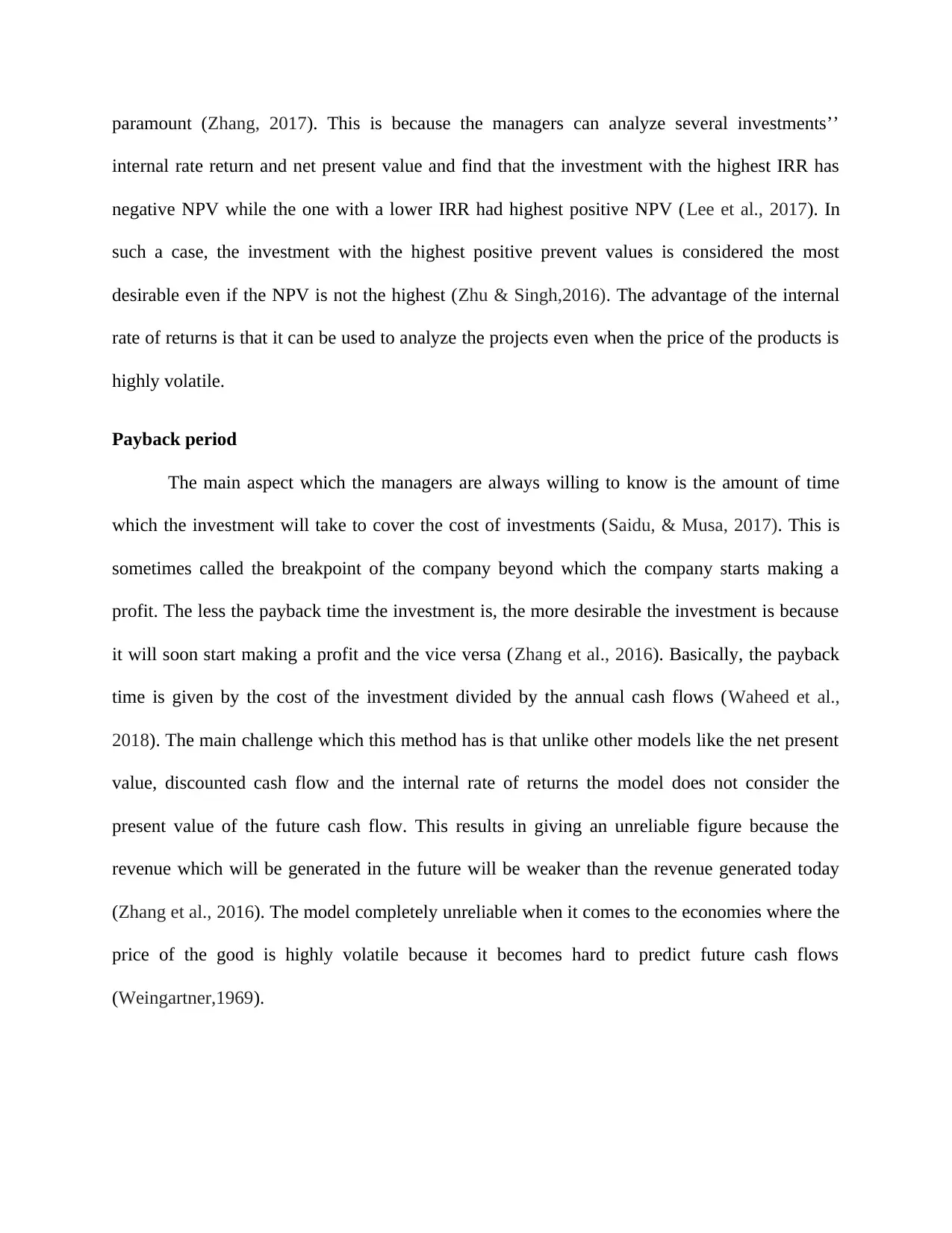
paramount (Zhang, 2017). This is because the managers can analyze several investments’’
internal rate return and net present value and find that the investment with the highest IRR has
negative NPV while the one with a lower IRR had highest positive NPV (Lee et al., 2017). In
such a case, the investment with the highest positive prevent values is considered the most
desirable even if the NPV is not the highest (Zhu & Singh,2016). The advantage of the internal
rate of returns is that it can be used to analyze the projects even when the price of the products is
highly volatile.
Payback period
The main aspect which the managers are always willing to know is the amount of time
which the investment will take to cover the cost of investments (Saidu, & Musa, 2017). This is
sometimes called the breakpoint of the company beyond which the company starts making a
profit. The less the payback time the investment is, the more desirable the investment is because
it will soon start making a profit and the vice versa (Zhang et al., 2016). Basically, the payback
time is given by the cost of the investment divided by the annual cash flows (Waheed et al.,
2018). The main challenge which this method has is that unlike other models like the net present
value, discounted cash flow and the internal rate of returns the model does not consider the
present value of the future cash flow. This results in giving an unreliable figure because the
revenue which will be generated in the future will be weaker than the revenue generated today
(Zhang et al., 2016). The model completely unreliable when it comes to the economies where the
price of the good is highly volatile because it becomes hard to predict future cash flows
(Weingartner,1969).
internal rate return and net present value and find that the investment with the highest IRR has
negative NPV while the one with a lower IRR had highest positive NPV (Lee et al., 2017). In
such a case, the investment with the highest positive prevent values is considered the most
desirable even if the NPV is not the highest (Zhu & Singh,2016). The advantage of the internal
rate of returns is that it can be used to analyze the projects even when the price of the products is
highly volatile.
Payback period
The main aspect which the managers are always willing to know is the amount of time
which the investment will take to cover the cost of investments (Saidu, & Musa, 2017). This is
sometimes called the breakpoint of the company beyond which the company starts making a
profit. The less the payback time the investment is, the more desirable the investment is because
it will soon start making a profit and the vice versa (Zhang et al., 2016). Basically, the payback
time is given by the cost of the investment divided by the annual cash flows (Waheed et al.,
2018). The main challenge which this method has is that unlike other models like the net present
value, discounted cash flow and the internal rate of returns the model does not consider the
present value of the future cash flow. This results in giving an unreliable figure because the
revenue which will be generated in the future will be weaker than the revenue generated today
(Zhang et al., 2016). The model completely unreliable when it comes to the economies where the
price of the good is highly volatile because it becomes hard to predict future cash flows
(Weingartner,1969).
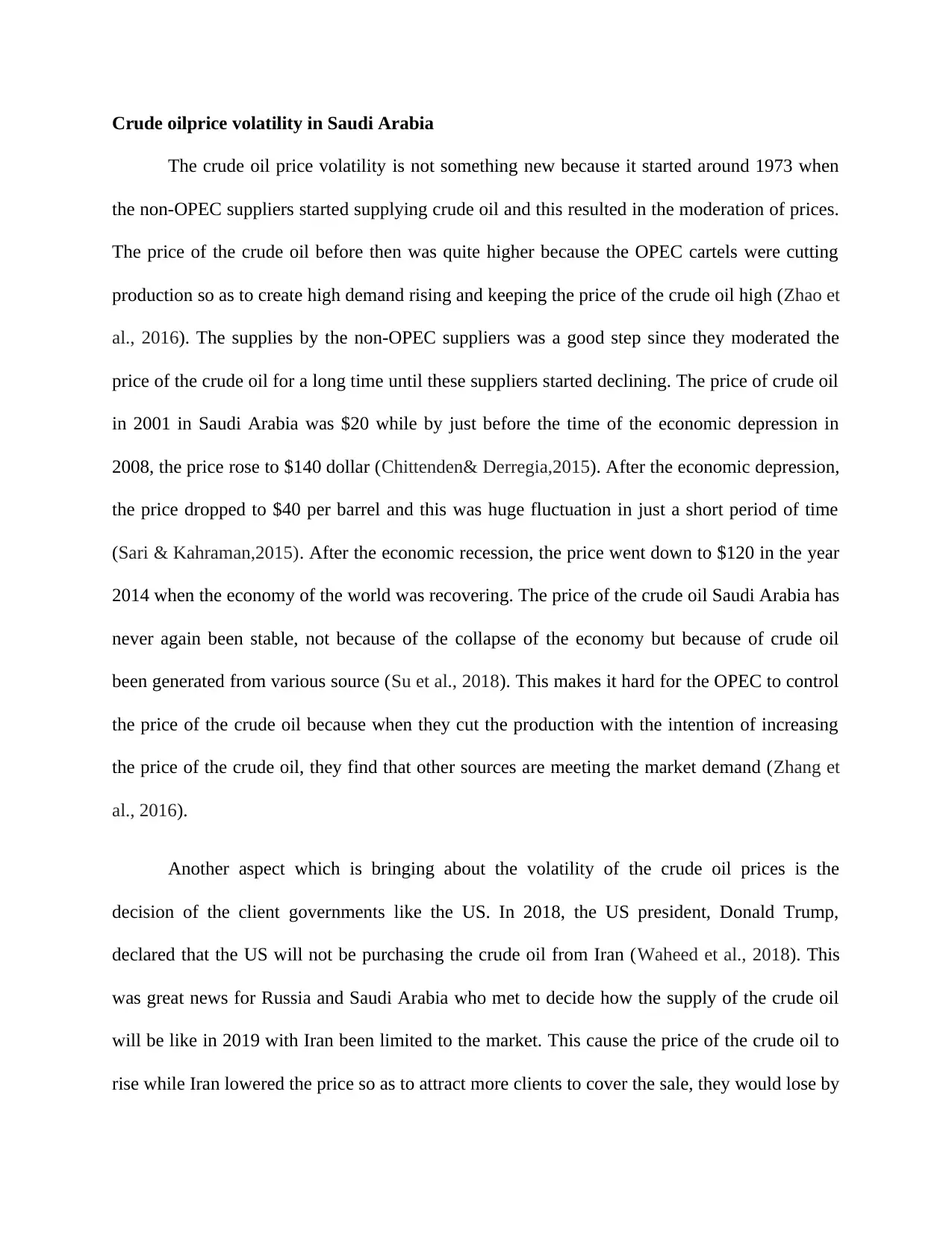
Crude oilprice volatility in Saudi Arabia
The crude oil price volatility is not something new because it started around 1973 when
the non-OPEC suppliers started supplying crude oil and this resulted in the moderation of prices.
The price of the crude oil before then was quite higher because the OPEC cartels were cutting
production so as to create high demand rising and keeping the price of the crude oil high (Zhao et
al., 2016). The supplies by the non-OPEC suppliers was a good step since they moderated the
price of the crude oil for a long time until these suppliers started declining. The price of crude oil
in 2001 in Saudi Arabia was $20 while by just before the time of the economic depression in
2008, the price rose to $140 dollar (Chittenden& Derregia,2015). After the economic depression,
the price dropped to $40 per barrel and this was huge fluctuation in just a short period of time
(Sari & Kahraman,2015). After the economic recession, the price went down to $120 in the year
2014 when the economy of the world was recovering. The price of the crude oil Saudi Arabia has
never again been stable, not because of the collapse of the economy but because of crude oil
been generated from various source (Su et al., 2018). This makes it hard for the OPEC to control
the price of the crude oil because when they cut the production with the intention of increasing
the price of the crude oil, they find that other sources are meeting the market demand (Zhang et
al., 2016).
Another aspect which is bringing about the volatility of the crude oil prices is the
decision of the client governments like the US. In 2018, the US president, Donald Trump,
declared that the US will not be purchasing the crude oil from Iran (Waheed et al., 2018). This
was great news for Russia and Saudi Arabia who met to decide how the supply of the crude oil
will be like in 2019 with Iran been limited to the market. This cause the price of the crude oil to
rise while Iran lowered the price so as to attract more clients to cover the sale, they would lose by
The crude oil price volatility is not something new because it started around 1973 when
the non-OPEC suppliers started supplying crude oil and this resulted in the moderation of prices.
The price of the crude oil before then was quite higher because the OPEC cartels were cutting
production so as to create high demand rising and keeping the price of the crude oil high (Zhao et
al., 2016). The supplies by the non-OPEC suppliers was a good step since they moderated the
price of the crude oil for a long time until these suppliers started declining. The price of crude oil
in 2001 in Saudi Arabia was $20 while by just before the time of the economic depression in
2008, the price rose to $140 dollar (Chittenden& Derregia,2015). After the economic depression,
the price dropped to $40 per barrel and this was huge fluctuation in just a short period of time
(Sari & Kahraman,2015). After the economic recession, the price went down to $120 in the year
2014 when the economy of the world was recovering. The price of the crude oil Saudi Arabia has
never again been stable, not because of the collapse of the economy but because of crude oil
been generated from various source (Su et al., 2018). This makes it hard for the OPEC to control
the price of the crude oil because when they cut the production with the intention of increasing
the price of the crude oil, they find that other sources are meeting the market demand (Zhang et
al., 2016).
Another aspect which is bringing about the volatility of the crude oil prices is the
decision of the client governments like the US. In 2018, the US president, Donald Trump,
declared that the US will not be purchasing the crude oil from Iran (Waheed et al., 2018). This
was great news for Russia and Saudi Arabia who met to decide how the supply of the crude oil
will be like in 2019 with Iran been limited to the market. This cause the price of the crude oil to
rise while Iran lowered the price so as to attract more clients to cover the sale, they would lose by
Secure Best Marks with AI Grader
Need help grading? Try our AI Grader for instant feedback on your assignments.
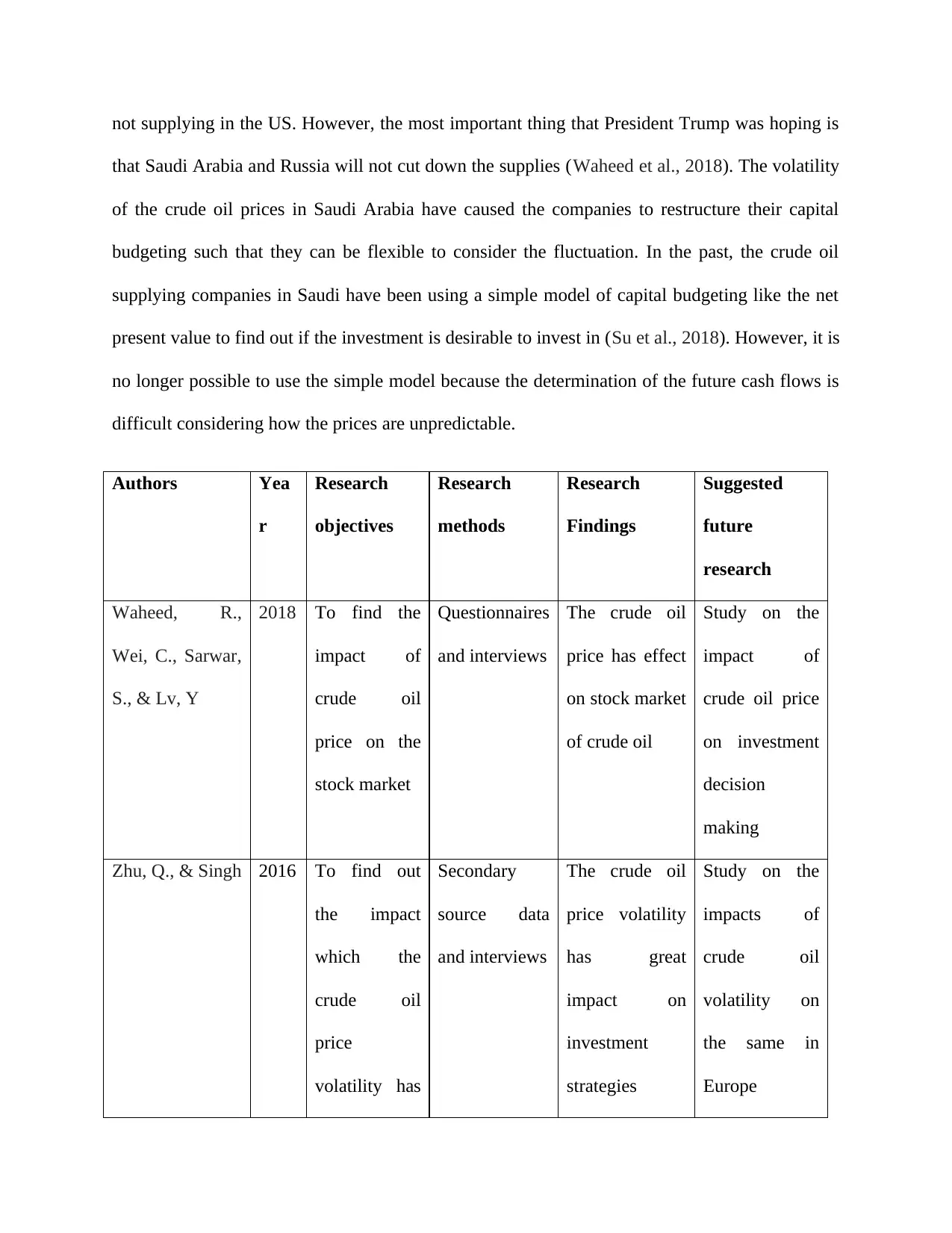
not supplying in the US. However, the most important thing that President Trump was hoping is
that Saudi Arabia and Russia will not cut down the supplies (Waheed et al., 2018). The volatility
of the crude oil prices in Saudi Arabia have caused the companies to restructure their capital
budgeting such that they can be flexible to consider the fluctuation. In the past, the crude oil
supplying companies in Saudi have been using a simple model of capital budgeting like the net
present value to find out if the investment is desirable to invest in (Su et al., 2018). However, it is
no longer possible to use the simple model because the determination of the future cash flows is
difficult considering how the prices are unpredictable.
Authors Yea
r
Research
objectives
Research
methods
Research
Findings
Suggested
future
research
Waheed, R.,
Wei, C., Sarwar,
S., & Lv, Y
2018 To find the
impact of
crude oil
price on the
stock market
Questionnaires
and interviews
The crude oil
price has effect
on stock market
of crude oil
Study on the
impact of
crude oil price
on investment
decision
making
Zhu, Q., & Singh 2016 To find out
the impact
which the
crude oil
price
volatility has
Secondary
source data
and interviews
The crude oil
price volatility
has great
impact on
investment
strategies
Study on the
impacts of
crude oil
volatility on
the same in
Europe
that Saudi Arabia and Russia will not cut down the supplies (Waheed et al., 2018). The volatility
of the crude oil prices in Saudi Arabia have caused the companies to restructure their capital
budgeting such that they can be flexible to consider the fluctuation. In the past, the crude oil
supplying companies in Saudi have been using a simple model of capital budgeting like the net
present value to find out if the investment is desirable to invest in (Su et al., 2018). However, it is
no longer possible to use the simple model because the determination of the future cash flows is
difficult considering how the prices are unpredictable.
Authors Yea
r
Research
objectives
Research
methods
Research
Findings
Suggested
future
research
Waheed, R.,
Wei, C., Sarwar,
S., & Lv, Y
2018 To find the
impact of
crude oil
price on the
stock market
Questionnaires
and interviews
The crude oil
price has effect
on stock market
of crude oil
Study on the
impact of
crude oil price
on investment
decision
making
Zhu, Q., & Singh 2016 To find out
the impact
which the
crude oil
price
volatility has
Secondary
source data
and interviews
The crude oil
price volatility
has great
impact on
investment
strategies
Study on the
impacts of
crude oil
volatility on
the same in
Europe
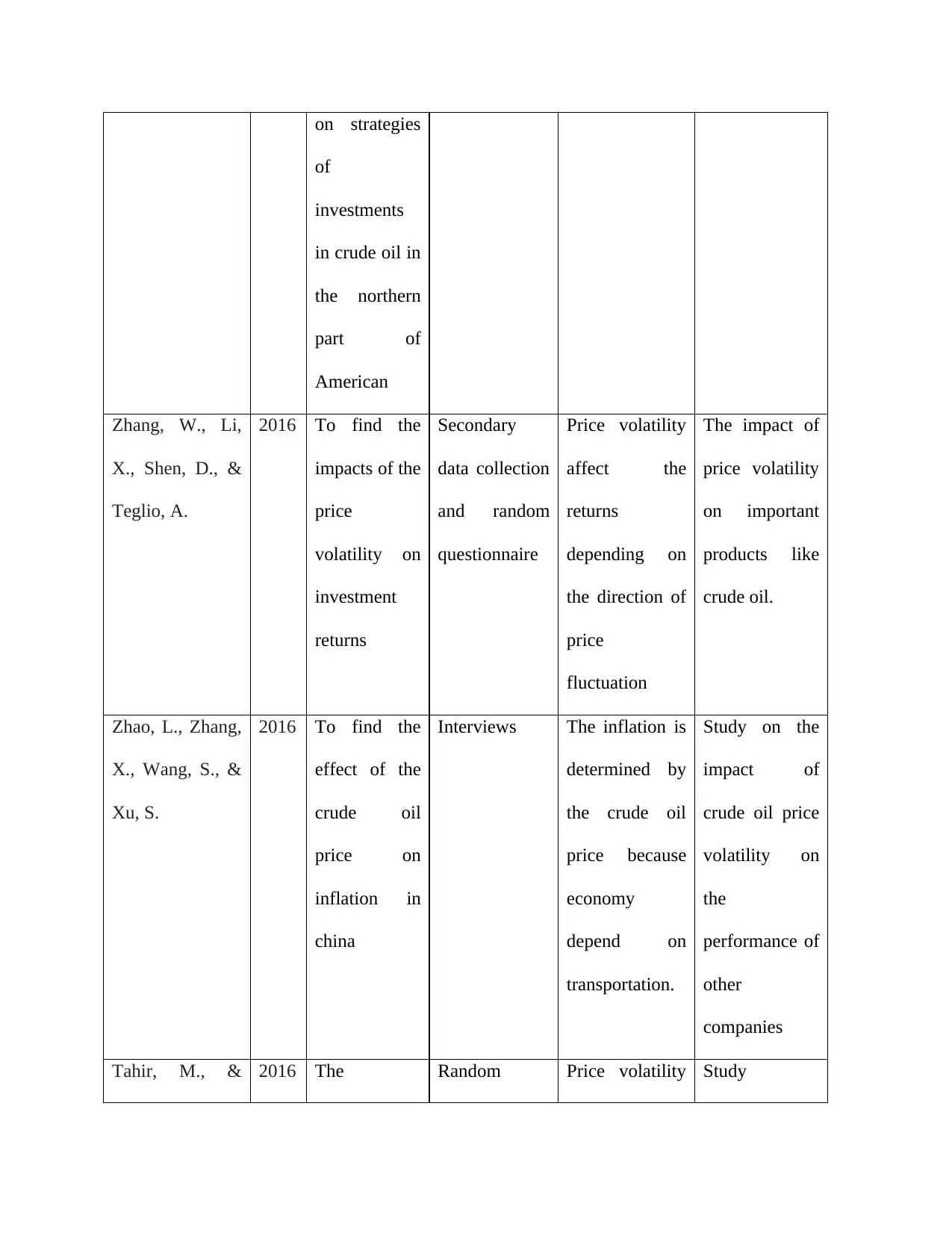
on strategies
of
investments
in crude oil in
the northern
part of
American
Zhang, W., Li,
X., Shen, D., &
Teglio, A.
2016 To find the
impacts of the
price
volatility on
investment
returns
Secondary
data collection
and random
questionnaire
Price volatility
affect the
returns
depending on
the direction of
price
fluctuation
The impact of
price volatility
on important
products like
crude oil.
Zhao, L., Zhang,
X., Wang, S., &
Xu, S.
2016 To find the
effect of the
crude oil
price on
inflation in
china
Interviews The inflation is
determined by
the crude oil
price because
economy
depend on
transportation.
Study on the
impact of
crude oil price
volatility on
the
performance of
other
companies
Tahir, M., & 2016 The Random Price volatility Study
of
investments
in crude oil in
the northern
part of
American
Zhang, W., Li,
X., Shen, D., &
Teglio, A.
2016 To find the
impacts of the
price
volatility on
investment
returns
Secondary
data collection
and random
questionnaire
Price volatility
affect the
returns
depending on
the direction of
price
fluctuation
The impact of
price volatility
on important
products like
crude oil.
Zhao, L., Zhang,
X., Wang, S., &
Xu, S.
2016 To find the
effect of the
crude oil
price on
inflation in
china
Interviews The inflation is
determined by
the crude oil
price because
economy
depend on
transportation.
Study on the
impact of
crude oil price
volatility on
the
performance of
other
companies
Tahir, M., & 2016 The Random Price volatility Study
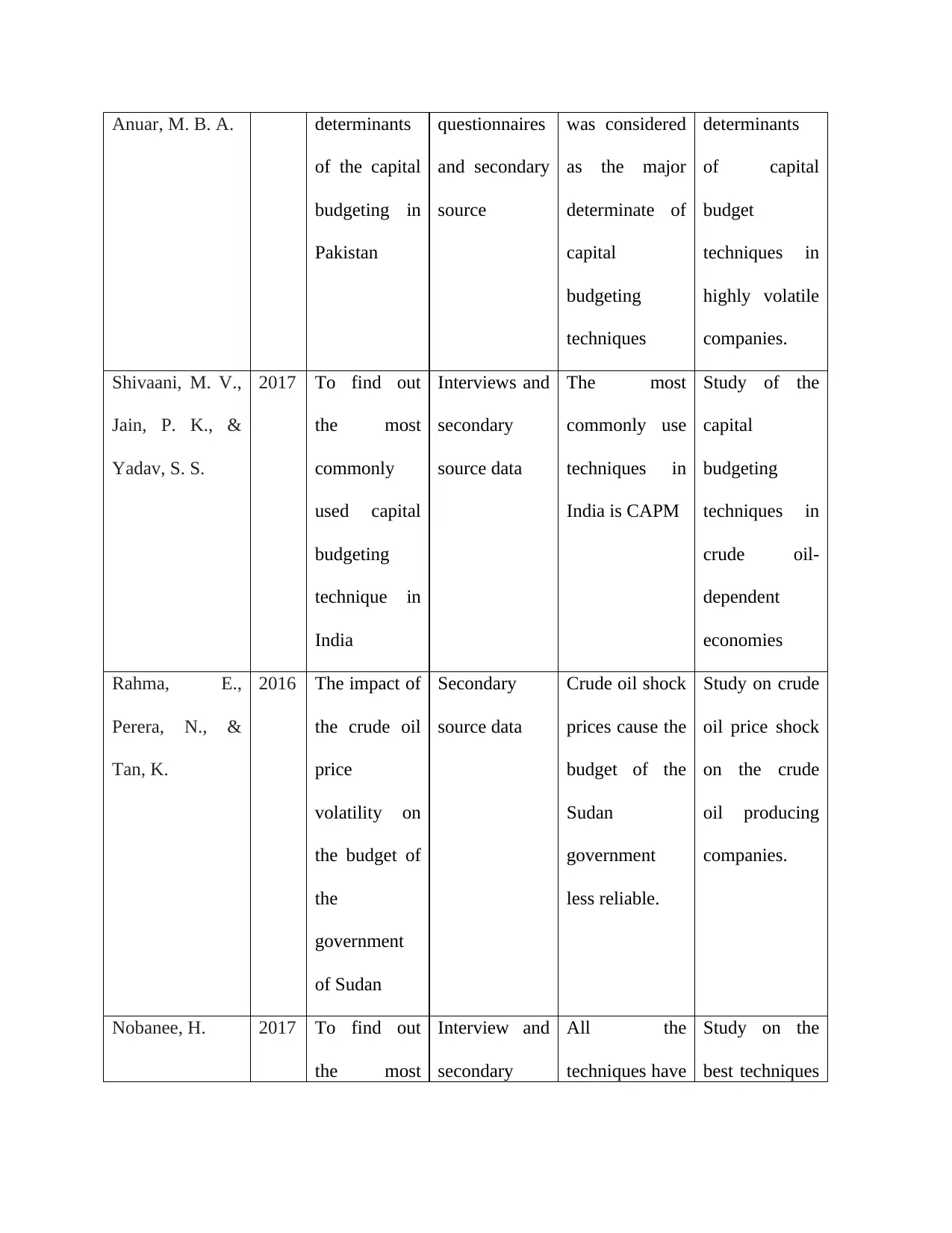
Anuar, M. B. A. determinants
of the capital
budgeting in
Pakistan
questionnaires
and secondary
source
was considered
as the major
determinate of
capital
budgeting
techniques
determinants
of capital
budget
techniques in
highly volatile
companies.
Shivaani, M. V.,
Jain, P. K., &
Yadav, S. S.
2017 To find out
the most
commonly
used capital
budgeting
technique in
India
Interviews and
secondary
source data
The most
commonly use
techniques in
India is CAPM
Study of the
capital
budgeting
techniques in
crude oil-
dependent
economies
Rahma, E.,
Perera, N., &
Tan, K.
2016 The impact of
the crude oil
price
volatility on
the budget of
the
government
of Sudan
Secondary
source data
Crude oil shock
prices cause the
budget of the
Sudan
government
less reliable.
Study on crude
oil price shock
on the crude
oil producing
companies.
Nobanee, H. 2017 To find out
the most
Interview and
secondary
All the
techniques have
Study on the
best techniques
of the capital
budgeting in
Pakistan
questionnaires
and secondary
source
was considered
as the major
determinate of
capital
budgeting
techniques
determinants
of capital
budget
techniques in
highly volatile
companies.
Shivaani, M. V.,
Jain, P. K., &
Yadav, S. S.
2017 To find out
the most
commonly
used capital
budgeting
technique in
India
Interviews and
secondary
source data
The most
commonly use
techniques in
India is CAPM
Study of the
capital
budgeting
techniques in
crude oil-
dependent
economies
Rahma, E.,
Perera, N., &
Tan, K.
2016 The impact of
the crude oil
price
volatility on
the budget of
the
government
of Sudan
Secondary
source data
Crude oil shock
prices cause the
budget of the
Sudan
government
less reliable.
Study on crude
oil price shock
on the crude
oil producing
companies.
Nobanee, H. 2017 To find out
the most
Interview and
secondary
All the
techniques have
Study on the
best techniques
Paraphrase This Document
Need a fresh take? Get an instant paraphrase of this document with our AI Paraphraser
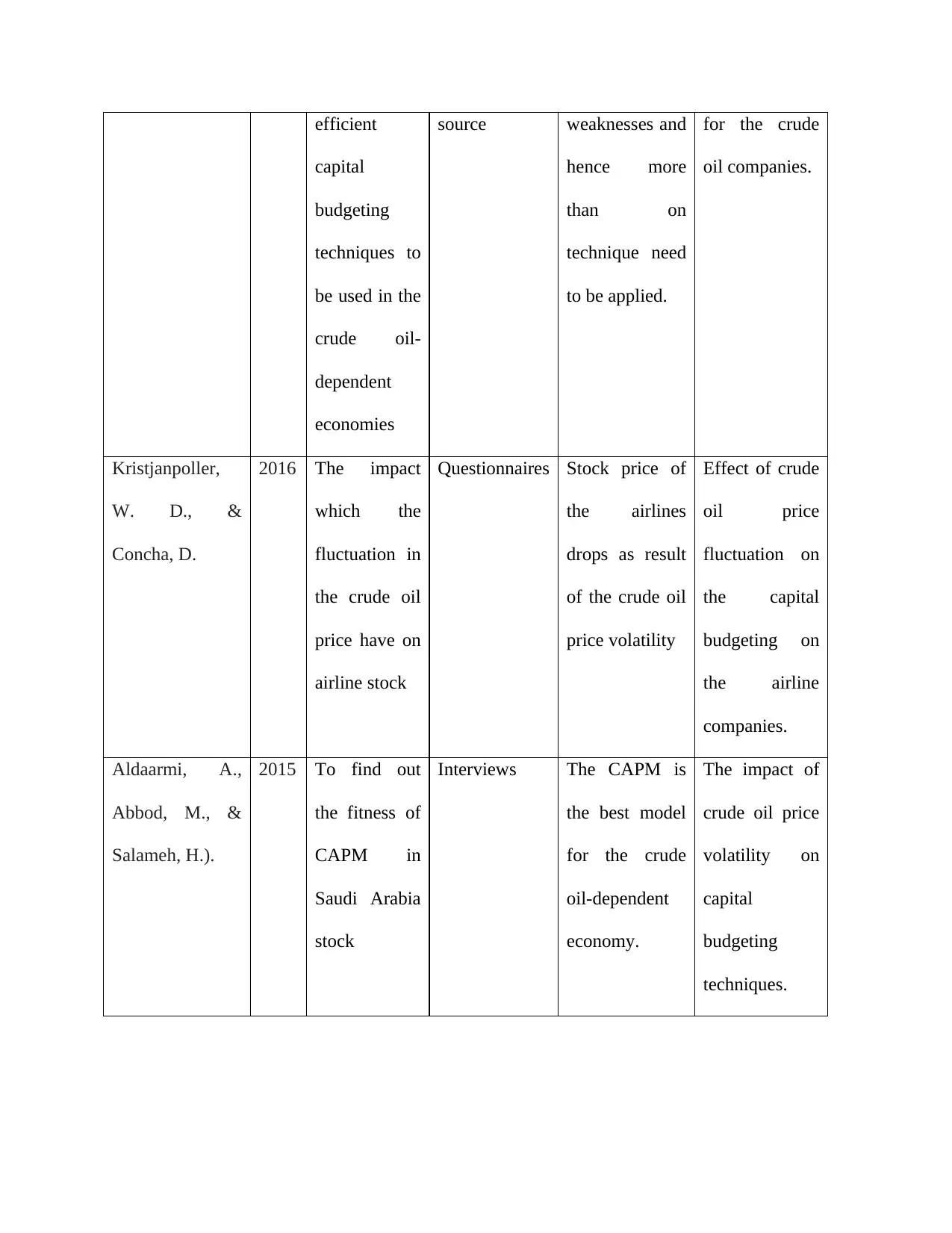
efficient
capital
budgeting
techniques to
be used in the
crude oil-
dependent
economies
source weaknesses and
hence more
than on
technique need
to be applied.
for the crude
oil companies.
Kristjanpoller,
W. D., &
Concha, D.
2016 The impact
which the
fluctuation in
the crude oil
price have on
airline stock
Questionnaires Stock price of
the airlines
drops as result
of the crude oil
price volatility
Effect of crude
oil price
fluctuation on
the capital
budgeting on
the airline
companies.
Aldaarmi, A.,
Abbod, M., &
Salameh, H.).
2015 To find out
the fitness of
CAPM in
Saudi Arabia
stock
Interviews The CAPM is
the best model
for the crude
oil-dependent
economy.
The impact of
crude oil price
volatility on
capital
budgeting
techniques.
capital
budgeting
techniques to
be used in the
crude oil-
dependent
economies
source weaknesses and
hence more
than on
technique need
to be applied.
for the crude
oil companies.
Kristjanpoller,
W. D., &
Concha, D.
2016 The impact
which the
fluctuation in
the crude oil
price have on
airline stock
Questionnaires Stock price of
the airlines
drops as result
of the crude oil
price volatility
Effect of crude
oil price
fluctuation on
the capital
budgeting on
the airline
companies.
Aldaarmi, A.,
Abbod, M., &
Salameh, H.).
2015 To find out
the fitness of
CAPM in
Saudi Arabia
stock
Interviews The CAPM is
the best model
for the crude
oil-dependent
economy.
The impact of
crude oil price
volatility on
capital
budgeting
techniques.
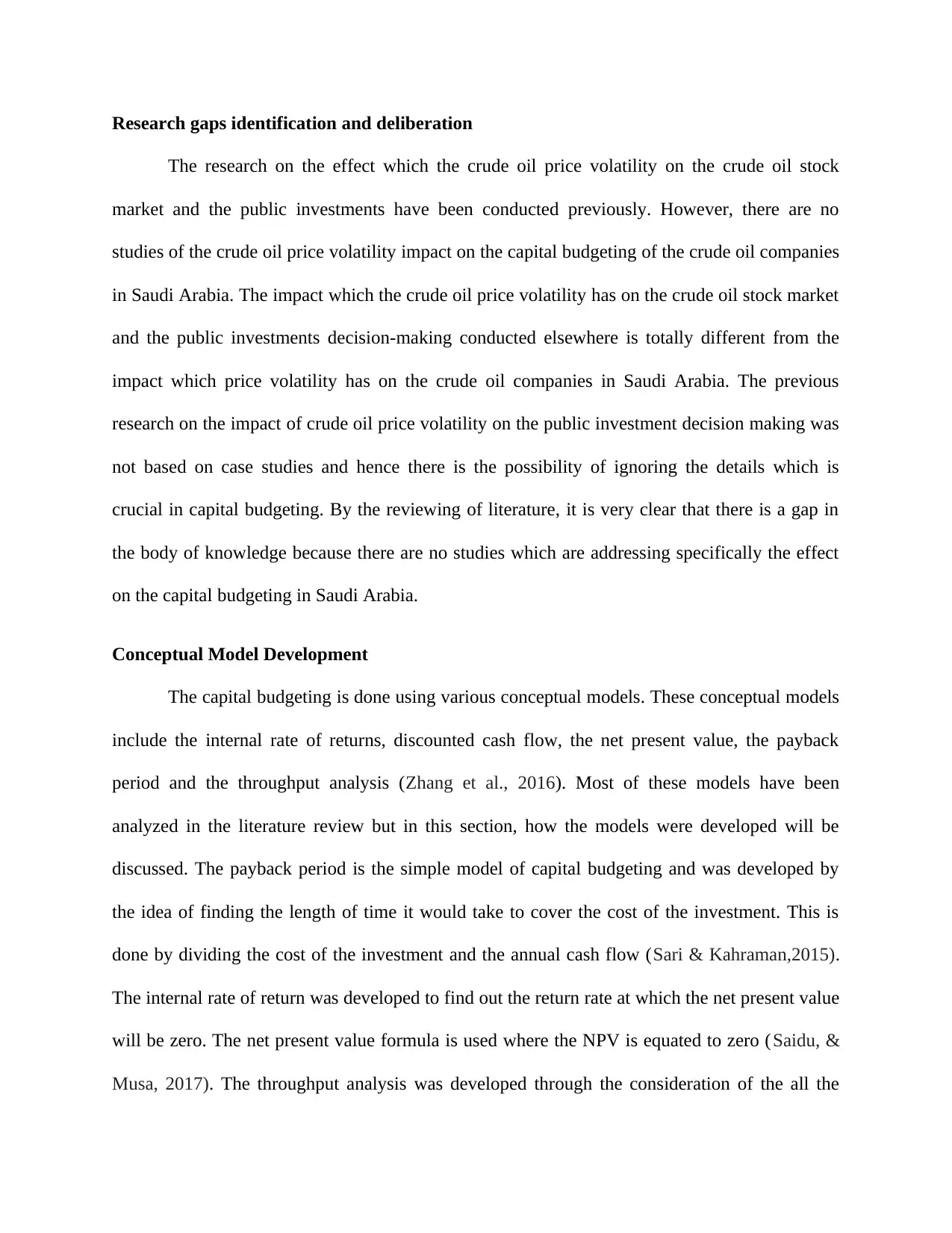
Research gaps identification and deliberation
The research on the effect which the crude oil price volatility on the crude oil stock
market and the public investments have been conducted previously. However, there are no
studies of the crude oil price volatility impact on the capital budgeting of the crude oil companies
in Saudi Arabia. The impact which the crude oil price volatility has on the crude oil stock market
and the public investments decision-making conducted elsewhere is totally different from the
impact which price volatility has on the crude oil companies in Saudi Arabia. The previous
research on the impact of crude oil price volatility on the public investment decision making was
not based on case studies and hence there is the possibility of ignoring the details which is
crucial in capital budgeting. By the reviewing of literature, it is very clear that there is a gap in
the body of knowledge because there are no studies which are addressing specifically the effect
on the capital budgeting in Saudi Arabia.
Conceptual Model Development
The capital budgeting is done using various conceptual models. These conceptual models
include the internal rate of returns, discounted cash flow, the net present value, the payback
period and the throughput analysis (Zhang et al., 2016). Most of these models have been
analyzed in the literature review but in this section, how the models were developed will be
discussed. The payback period is the simple model of capital budgeting and was developed by
the idea of finding the length of time it would take to cover the cost of the investment. This is
done by dividing the cost of the investment and the annual cash flow (Sari & Kahraman,2015).
The internal rate of return was developed to find out the return rate at which the net present value
will be zero. The net present value formula is used where the NPV is equated to zero (Saidu, &
Musa, 2017). The throughput analysis was developed through the consideration of the all the
The research on the effect which the crude oil price volatility on the crude oil stock
market and the public investments have been conducted previously. However, there are no
studies of the crude oil price volatility impact on the capital budgeting of the crude oil companies
in Saudi Arabia. The impact which the crude oil price volatility has on the crude oil stock market
and the public investments decision-making conducted elsewhere is totally different from the
impact which price volatility has on the crude oil companies in Saudi Arabia. The previous
research on the impact of crude oil price volatility on the public investment decision making was
not based on case studies and hence there is the possibility of ignoring the details which is
crucial in capital budgeting. By the reviewing of literature, it is very clear that there is a gap in
the body of knowledge because there are no studies which are addressing specifically the effect
on the capital budgeting in Saudi Arabia.
Conceptual Model Development
The capital budgeting is done using various conceptual models. These conceptual models
include the internal rate of returns, discounted cash flow, the net present value, the payback
period and the throughput analysis (Zhang et al., 2016). Most of these models have been
analyzed in the literature review but in this section, how the models were developed will be
discussed. The payback period is the simple model of capital budgeting and was developed by
the idea of finding the length of time it would take to cover the cost of the investment. This is
done by dividing the cost of the investment and the annual cash flow (Sari & Kahraman,2015).
The internal rate of return was developed to find out the return rate at which the net present value
will be zero. The net present value formula is used where the NPV is equated to zero (Saidu, &
Musa, 2017). The throughput analysis was developed through the consideration of the all the
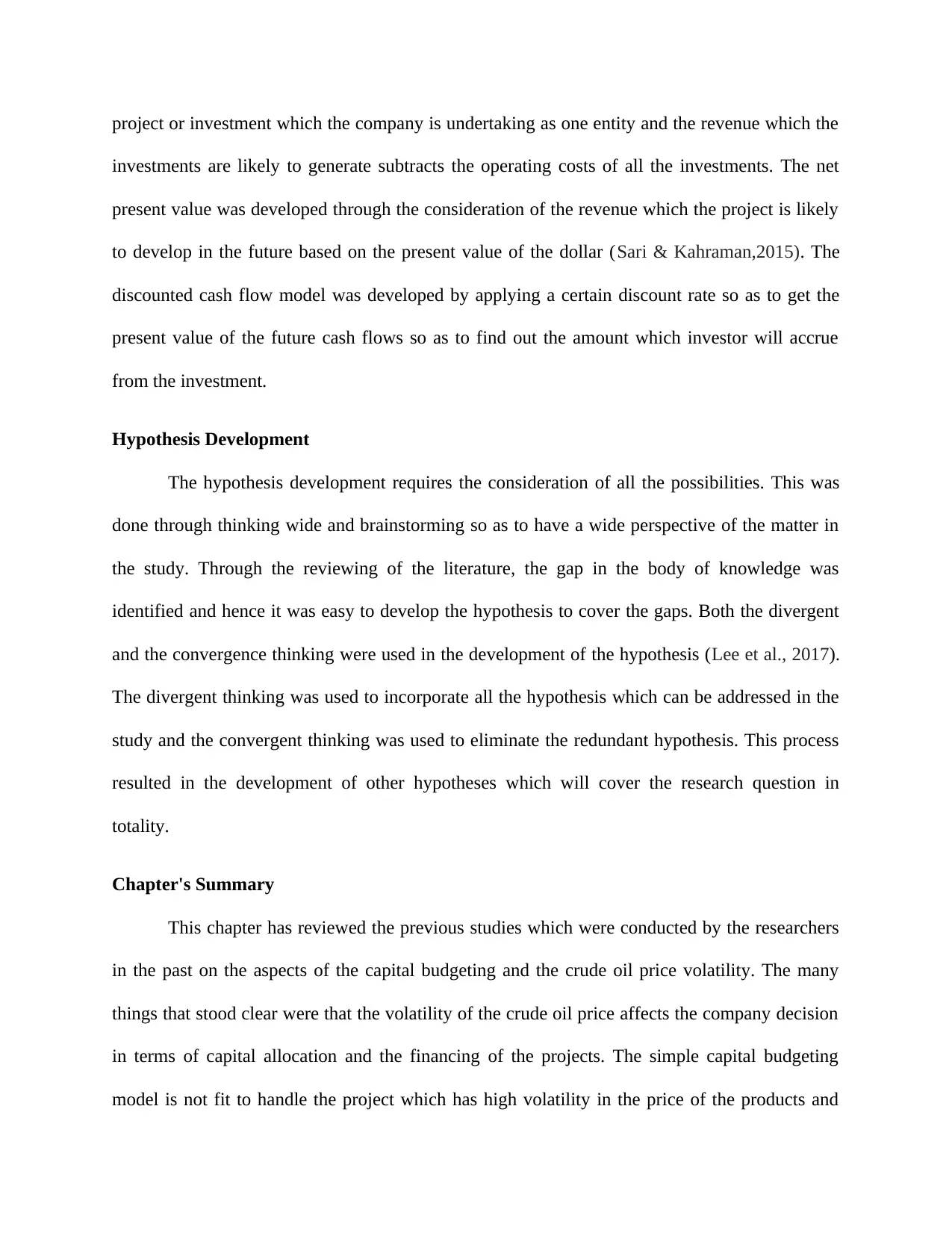
project or investment which the company is undertaking as one entity and the revenue which the
investments are likely to generate subtracts the operating costs of all the investments. The net
present value was developed through the consideration of the revenue which the project is likely
to develop in the future based on the present value of the dollar (Sari & Kahraman,2015). The
discounted cash flow model was developed by applying a certain discount rate so as to get the
present value of the future cash flows so as to find out the amount which investor will accrue
from the investment.
Hypothesis Development
The hypothesis development requires the consideration of all the possibilities. This was
done through thinking wide and brainstorming so as to have a wide perspective of the matter in
the study. Through the reviewing of the literature, the gap in the body of knowledge was
identified and hence it was easy to develop the hypothesis to cover the gaps. Both the divergent
and the convergence thinking were used in the development of the hypothesis (Lee et al., 2017).
The divergent thinking was used to incorporate all the hypothesis which can be addressed in the
study and the convergent thinking was used to eliminate the redundant hypothesis. This process
resulted in the development of other hypotheses which will cover the research question in
totality.
Chapter's Summary
This chapter has reviewed the previous studies which were conducted by the researchers
in the past on the aspects of the capital budgeting and the crude oil price volatility. The many
things that stood clear were that the volatility of the crude oil price affects the company decision
in terms of capital allocation and the financing of the projects. The simple capital budgeting
model is not fit to handle the project which has high volatility in the price of the products and
investments are likely to generate subtracts the operating costs of all the investments. The net
present value was developed through the consideration of the revenue which the project is likely
to develop in the future based on the present value of the dollar (Sari & Kahraman,2015). The
discounted cash flow model was developed by applying a certain discount rate so as to get the
present value of the future cash flows so as to find out the amount which investor will accrue
from the investment.
Hypothesis Development
The hypothesis development requires the consideration of all the possibilities. This was
done through thinking wide and brainstorming so as to have a wide perspective of the matter in
the study. Through the reviewing of the literature, the gap in the body of knowledge was
identified and hence it was easy to develop the hypothesis to cover the gaps. Both the divergent
and the convergence thinking were used in the development of the hypothesis (Lee et al., 2017).
The divergent thinking was used to incorporate all the hypothesis which can be addressed in the
study and the convergent thinking was used to eliminate the redundant hypothesis. This process
resulted in the development of other hypotheses which will cover the research question in
totality.
Chapter's Summary
This chapter has reviewed the previous studies which were conducted by the researchers
in the past on the aspects of the capital budgeting and the crude oil price volatility. The many
things that stood clear were that the volatility of the crude oil price affects the company decision
in terms of capital allocation and the financing of the projects. The simple capital budgeting
model is not fit to handle the project which has high volatility in the price of the products and
Secure Best Marks with AI Grader
Need help grading? Try our AI Grader for instant feedback on your assignments.
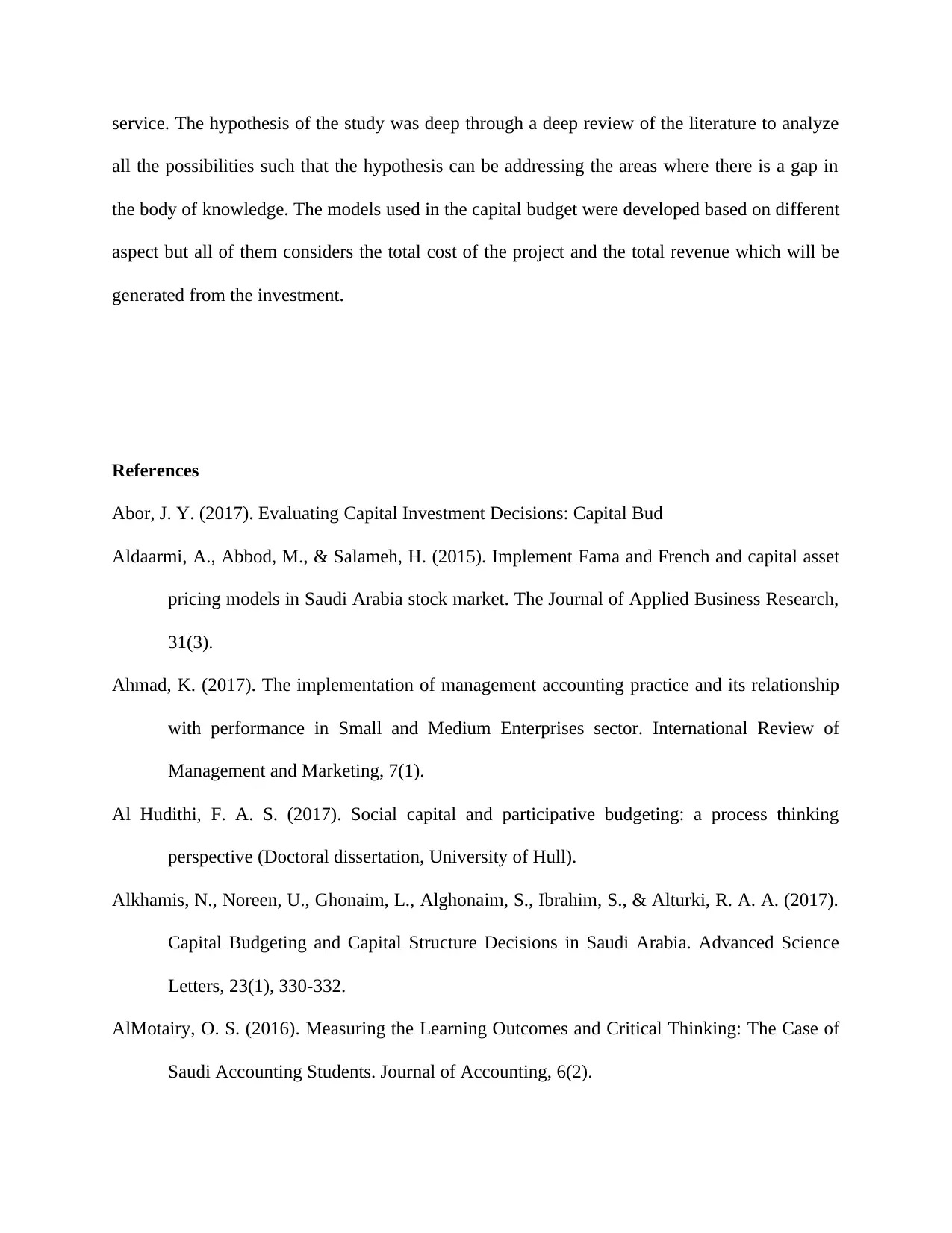
service. The hypothesis of the study was deep through a deep review of the literature to analyze
all the possibilities such that the hypothesis can be addressing the areas where there is a gap in
the body of knowledge. The models used in the capital budget were developed based on different
aspect but all of them considers the total cost of the project and the total revenue which will be
generated from the investment.
References
Abor, J. Y. (2017). Evaluating Capital Investment Decisions: Capital Bud
Aldaarmi, A., Abbod, M., & Salameh, H. (2015). Implement Fama and French and capital asset
pricing models in Saudi Arabia stock market. The Journal of Applied Business Research,
31(3).
Ahmad, K. (2017). The implementation of management accounting practice and its relationship
with performance in Small and Medium Enterprises sector. International Review of
Management and Marketing, 7(1).
Al Hudithi, F. A. S. (2017). Social capital and participative budgeting: a process thinking
perspective (Doctoral dissertation, University of Hull).
Alkhamis, N., Noreen, U., Ghonaim, L., Alghonaim, S., Ibrahim, S., & Alturki, R. A. A. (2017).
Capital Budgeting and Capital Structure Decisions in Saudi Arabia. Advanced Science
Letters, 23(1), 330-332.
AlMotairy, O. S. (2016). Measuring the Learning Outcomes and Critical Thinking: The Case of
Saudi Accounting Students. Journal of Accounting, 6(2).
all the possibilities such that the hypothesis can be addressing the areas where there is a gap in
the body of knowledge. The models used in the capital budget were developed based on different
aspect but all of them considers the total cost of the project and the total revenue which will be
generated from the investment.
References
Abor, J. Y. (2017). Evaluating Capital Investment Decisions: Capital Bud
Aldaarmi, A., Abbod, M., & Salameh, H. (2015). Implement Fama and French and capital asset
pricing models in Saudi Arabia stock market. The Journal of Applied Business Research,
31(3).
Ahmad, K. (2017). The implementation of management accounting practice and its relationship
with performance in Small and Medium Enterprises sector. International Review of
Management and Marketing, 7(1).
Al Hudithi, F. A. S. (2017). Social capital and participative budgeting: a process thinking
perspective (Doctoral dissertation, University of Hull).
Alkhamis, N., Noreen, U., Ghonaim, L., Alghonaim, S., Ibrahim, S., & Alturki, R. A. A. (2017).
Capital Budgeting and Capital Structure Decisions in Saudi Arabia. Advanced Science
Letters, 23(1), 330-332.
AlMotairy, O. S. (2016). Measuring the Learning Outcomes and Critical Thinking: The Case of
Saudi Accounting Students. Journal of Accounting, 6(2).
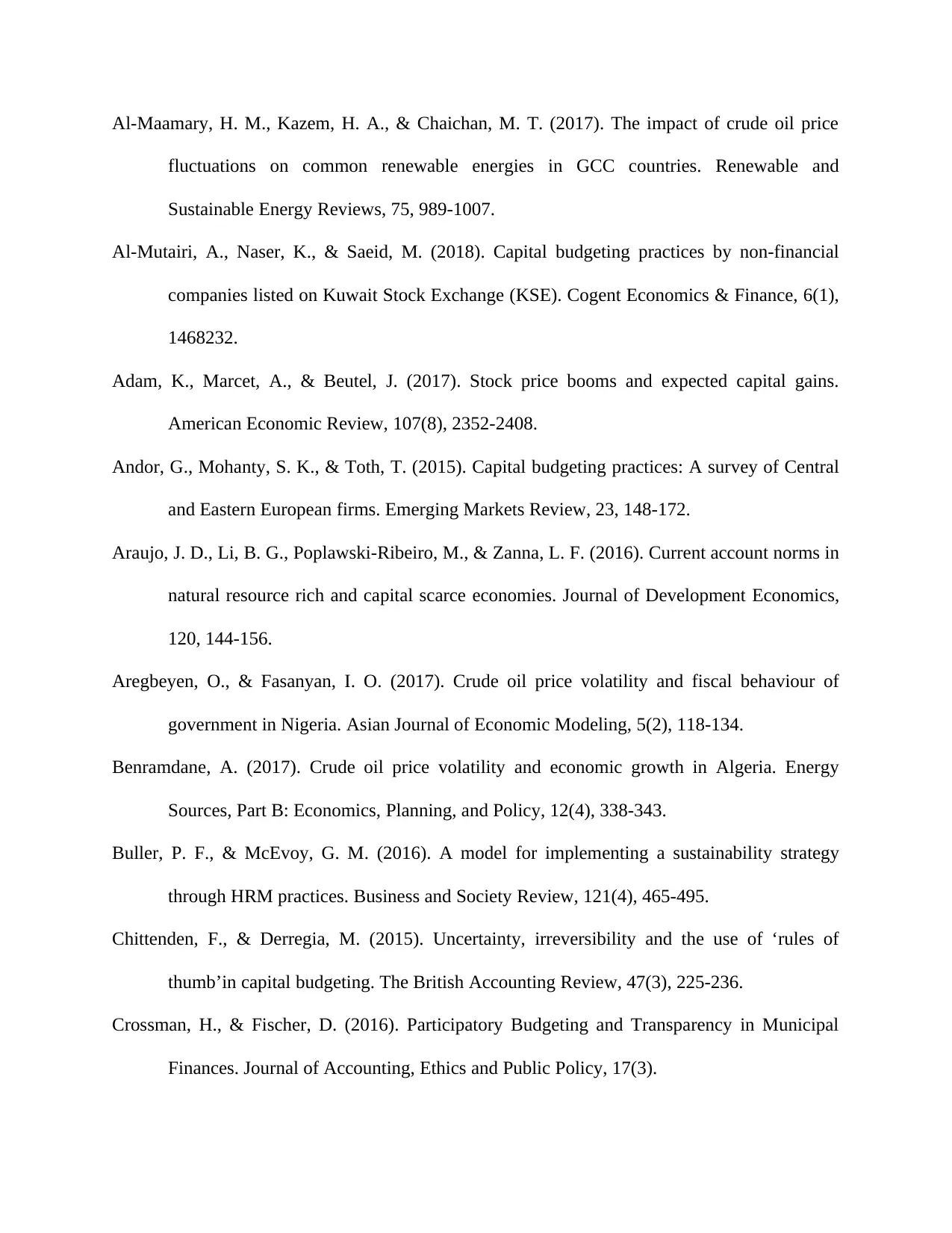
Al-Maamary, H. M., Kazem, H. A., & Chaichan, M. T. (2017). The impact of crude oil price
fluctuations on common renewable energies in GCC countries. Renewable and
Sustainable Energy Reviews, 75, 989-1007.
Al-Mutairi, A., Naser, K., & Saeid, M. (2018). Capital budgeting practices by non-financial
companies listed on Kuwait Stock Exchange (KSE). Cogent Economics & Finance, 6(1),
1468232.
Adam, K., Marcet, A., & Beutel, J. (2017). Stock price booms and expected capital gains.
American Economic Review, 107(8), 2352-2408.
Andor, G., Mohanty, S. K., & Toth, T. (2015). Capital budgeting practices: A survey of Central
and Eastern European firms. Emerging Markets Review, 23, 148-172.
Araujo, J. D., Li, B. G., Poplawski-Ribeiro, M., & Zanna, L. F. (2016). Current account norms in
natural resource rich and capital scarce economies. Journal of Development Economics,
120, 144-156.
Aregbeyen, O., & Fasanyan, I. O. (2017). Crude oil price volatility and fiscal behaviour of
government in Nigeria. Asian Journal of Economic Modeling, 5(2), 118-134.
Benramdane, A. (2017). Crude oil price volatility and economic growth in Algeria. Energy
Sources, Part B: Economics, Planning, and Policy, 12(4), 338-343.
Buller, P. F., & McEvoy, G. M. (2016). A model for implementing a sustainability strategy
through HRM practices. Business and Society Review, 121(4), 465-495.
Chittenden, F., & Derregia, M. (2015). Uncertainty, irreversibility and the use of ‘rules of
thumb’in capital budgeting. The British Accounting Review, 47(3), 225-236.
Crossman, H., & Fischer, D. (2016). Participatory Budgeting and Transparency in Municipal
Finances. Journal of Accounting, Ethics and Public Policy, 17(3).
fluctuations on common renewable energies in GCC countries. Renewable and
Sustainable Energy Reviews, 75, 989-1007.
Al-Mutairi, A., Naser, K., & Saeid, M. (2018). Capital budgeting practices by non-financial
companies listed on Kuwait Stock Exchange (KSE). Cogent Economics & Finance, 6(1),
1468232.
Adam, K., Marcet, A., & Beutel, J. (2017). Stock price booms and expected capital gains.
American Economic Review, 107(8), 2352-2408.
Andor, G., Mohanty, S. K., & Toth, T. (2015). Capital budgeting practices: A survey of Central
and Eastern European firms. Emerging Markets Review, 23, 148-172.
Araujo, J. D., Li, B. G., Poplawski-Ribeiro, M., & Zanna, L. F. (2016). Current account norms in
natural resource rich and capital scarce economies. Journal of Development Economics,
120, 144-156.
Aregbeyen, O., & Fasanyan, I. O. (2017). Crude oil price volatility and fiscal behaviour of
government in Nigeria. Asian Journal of Economic Modeling, 5(2), 118-134.
Benramdane, A. (2017). Crude oil price volatility and economic growth in Algeria. Energy
Sources, Part B: Economics, Planning, and Policy, 12(4), 338-343.
Buller, P. F., & McEvoy, G. M. (2016). A model for implementing a sustainability strategy
through HRM practices. Business and Society Review, 121(4), 465-495.
Chittenden, F., & Derregia, M. (2015). Uncertainty, irreversibility and the use of ‘rules of
thumb’in capital budgeting. The British Accounting Review, 47(3), 225-236.
Crossman, H., & Fischer, D. (2016). Participatory Budgeting and Transparency in Municipal
Finances. Journal of Accounting, Ethics and Public Policy, 17(3).
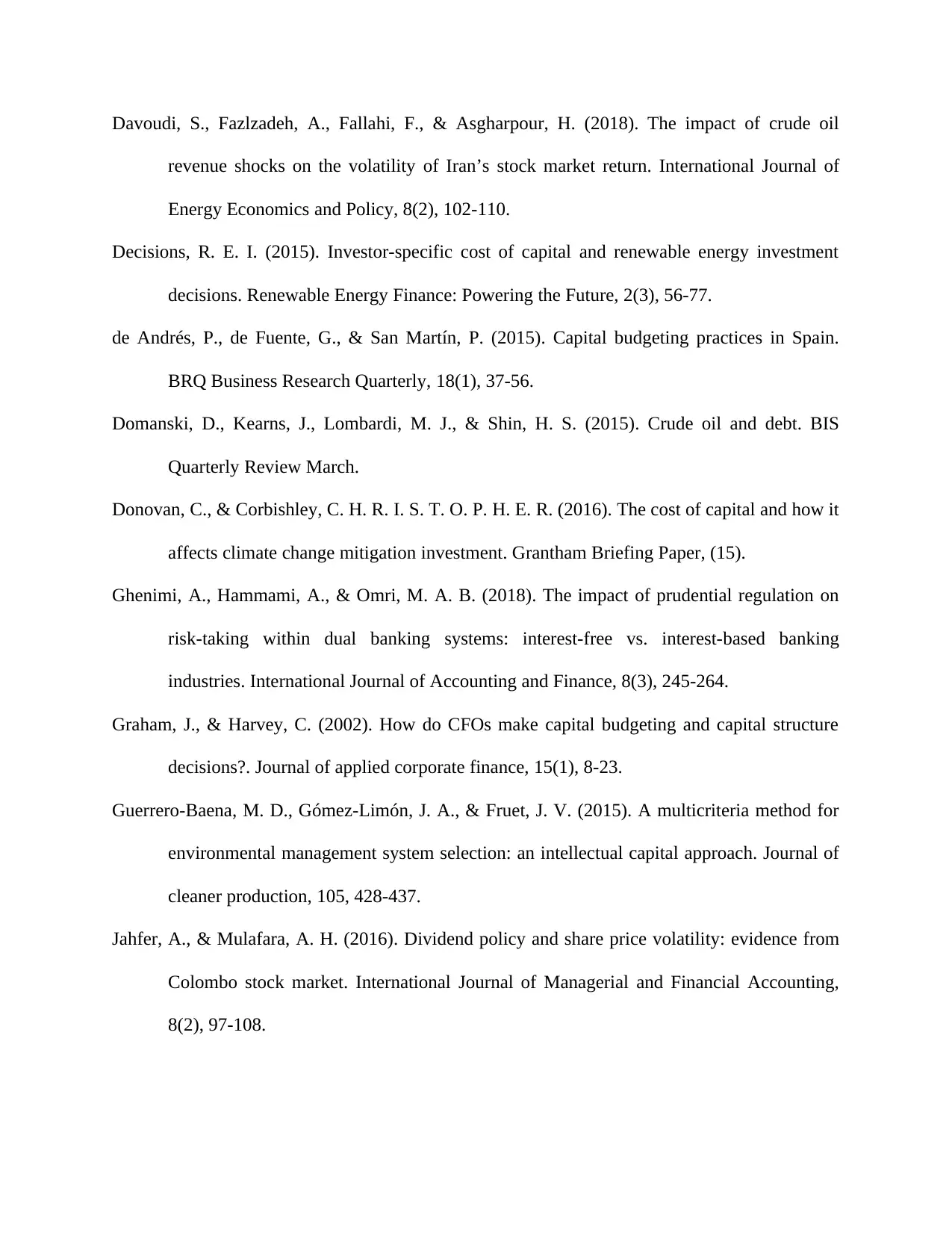
Davoudi, S., Fazlzadeh, A., Fallahi, F., & Asgharpour, H. (2018). The impact of crude oil
revenue shocks on the volatility of Iran’s stock market return. International Journal of
Energy Economics and Policy, 8(2), 102-110.
Decisions, R. E. I. (2015). Investor-specific cost of capital and renewable energy investment
decisions. Renewable Energy Finance: Powering the Future, 2(3), 56-77.
de Andrés, P., de Fuente, G., & San Martín, P. (2015). Capital budgeting practices in Spain.
BRQ Business Research Quarterly, 18(1), 37-56.
Domanski, D., Kearns, J., Lombardi, M. J., & Shin, H. S. (2015). Crude oil and debt. BIS
Quarterly Review March.
Donovan, C., & Corbishley, C. H. R. I. S. T. O. P. H. E. R. (2016). The cost of capital and how it
affects climate change mitigation investment. Grantham Briefing Paper, (15).
Ghenimi, A., Hammami, A., & Omri, M. A. B. (2018). The impact of prudential regulation on
risk-taking within dual banking systems: interest-free vs. interest-based banking
industries. International Journal of Accounting and Finance, 8(3), 245-264.
Graham, J., & Harvey, C. (2002). How do CFOs make capital budgeting and capital structure
decisions?. Journal of applied corporate finance, 15(1), 8-23.
Guerrero-Baena, M. D., Gómez-Limón, J. A., & Fruet, J. V. (2015). A multicriteria method for
environmental management system selection: an intellectual capital approach. Journal of
cleaner production, 105, 428-437.
Jahfer, A., & Mulafara, A. H. (2016). Dividend policy and share price volatility: evidence from
Colombo stock market. International Journal of Managerial and Financial Accounting,
8(2), 97-108.
revenue shocks on the volatility of Iran’s stock market return. International Journal of
Energy Economics and Policy, 8(2), 102-110.
Decisions, R. E. I. (2015). Investor-specific cost of capital and renewable energy investment
decisions. Renewable Energy Finance: Powering the Future, 2(3), 56-77.
de Andrés, P., de Fuente, G., & San Martín, P. (2015). Capital budgeting practices in Spain.
BRQ Business Research Quarterly, 18(1), 37-56.
Domanski, D., Kearns, J., Lombardi, M. J., & Shin, H. S. (2015). Crude oil and debt. BIS
Quarterly Review March.
Donovan, C., & Corbishley, C. H. R. I. S. T. O. P. H. E. R. (2016). The cost of capital and how it
affects climate change mitigation investment. Grantham Briefing Paper, (15).
Ghenimi, A., Hammami, A., & Omri, M. A. B. (2018). The impact of prudential regulation on
risk-taking within dual banking systems: interest-free vs. interest-based banking
industries. International Journal of Accounting and Finance, 8(3), 245-264.
Graham, J., & Harvey, C. (2002). How do CFOs make capital budgeting and capital structure
decisions?. Journal of applied corporate finance, 15(1), 8-23.
Guerrero-Baena, M. D., Gómez-Limón, J. A., & Fruet, J. V. (2015). A multicriteria method for
environmental management system selection: an intellectual capital approach. Journal of
cleaner production, 105, 428-437.
Jahfer, A., & Mulafara, A. H. (2016). Dividend policy and share price volatility: evidence from
Colombo stock market. International Journal of Managerial and Financial Accounting,
8(2), 97-108.
Paraphrase This Document
Need a fresh take? Get an instant paraphrase of this document with our AI Paraphraser
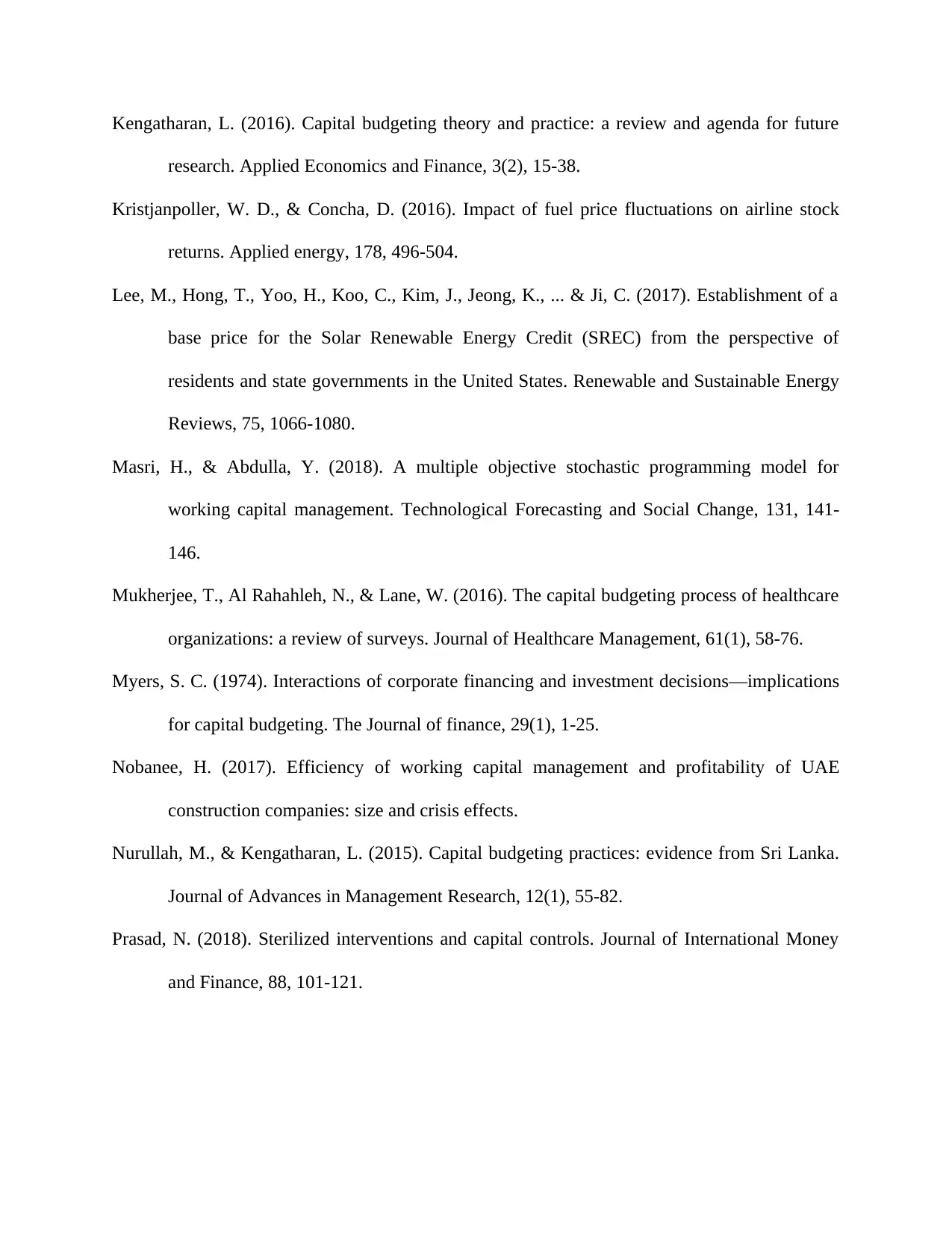
Kengatharan, L. (2016). Capital budgeting theory and practice: a review and agenda for future
research. Applied Economics and Finance, 3(2), 15-38.
Kristjanpoller, W. D., & Concha, D. (2016). Impact of fuel price fluctuations on airline stock
returns. Applied energy, 178, 496-504.
Lee, M., Hong, T., Yoo, H., Koo, C., Kim, J., Jeong, K., ... & Ji, C. (2017). Establishment of a
base price for the Solar Renewable Energy Credit (SREC) from the perspective of
residents and state governments in the United States. Renewable and Sustainable Energy
Reviews, 75, 1066-1080.
Masri, H., & Abdulla, Y. (2018). A multiple objective stochastic programming model for
working capital management. Technological Forecasting and Social Change, 131, 141-
146.
Mukherjee, T., Al Rahahleh, N., & Lane, W. (2016). The capital budgeting process of healthcare
organizations: a review of surveys. Journal of Healthcare Management, 61(1), 58-76.
Myers, S. C. (1974). Interactions of corporate financing and investment decisions—implications
for capital budgeting. The Journal of finance, 29(1), 1-25.
Nobanee, H. (2017). Efficiency of working capital management and profitability of UAE
construction companies: size and crisis effects.
Nurullah, M., & Kengatharan, L. (2015). Capital budgeting practices: evidence from Sri Lanka.
Journal of Advances in Management Research, 12(1), 55-82.
Prasad, N. (2018). Sterilized interventions and capital controls. Journal of International Money
and Finance, 88, 101-121.
research. Applied Economics and Finance, 3(2), 15-38.
Kristjanpoller, W. D., & Concha, D. (2016). Impact of fuel price fluctuations on airline stock
returns. Applied energy, 178, 496-504.
Lee, M., Hong, T., Yoo, H., Koo, C., Kim, J., Jeong, K., ... & Ji, C. (2017). Establishment of a
base price for the Solar Renewable Energy Credit (SREC) from the perspective of
residents and state governments in the United States. Renewable and Sustainable Energy
Reviews, 75, 1066-1080.
Masri, H., & Abdulla, Y. (2018). A multiple objective stochastic programming model for
working capital management. Technological Forecasting and Social Change, 131, 141-
146.
Mukherjee, T., Al Rahahleh, N., & Lane, W. (2016). The capital budgeting process of healthcare
organizations: a review of surveys. Journal of Healthcare Management, 61(1), 58-76.
Myers, S. C. (1974). Interactions of corporate financing and investment decisions—implications
for capital budgeting. The Journal of finance, 29(1), 1-25.
Nobanee, H. (2017). Efficiency of working capital management and profitability of UAE
construction companies: size and crisis effects.
Nurullah, M., & Kengatharan, L. (2015). Capital budgeting practices: evidence from Sri Lanka.
Journal of Advances in Management Research, 12(1), 55-82.
Prasad, N. (2018). Sterilized interventions and capital controls. Journal of International Money
and Finance, 88, 101-121.
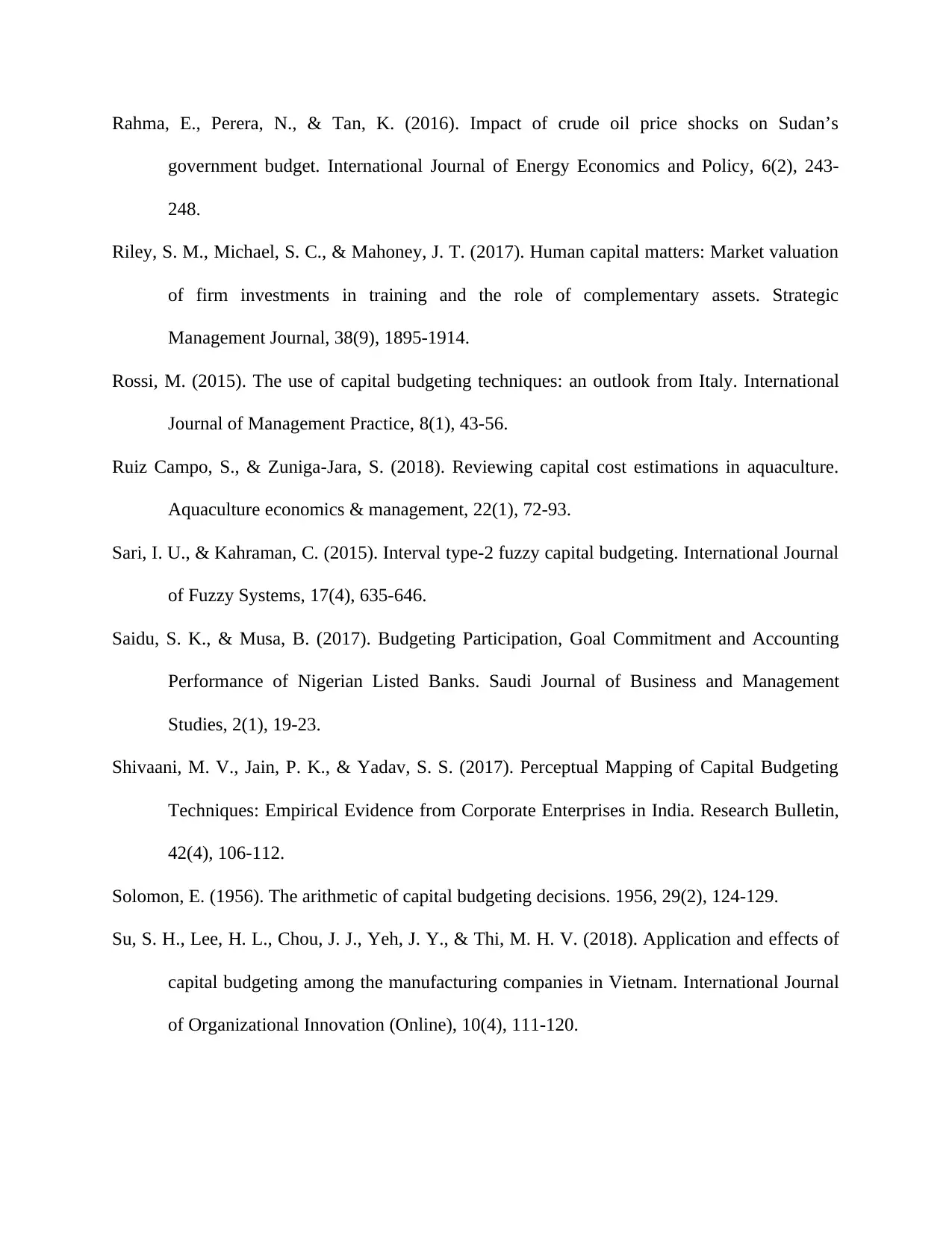
Rahma, E., Perera, N., & Tan, K. (2016). Impact of crude oil price shocks on Sudan’s
government budget. International Journal of Energy Economics and Policy, 6(2), 243-
248.
Riley, S. M., Michael, S. C., & Mahoney, J. T. (2017). Human capital matters: Market valuation
of firm investments in training and the role of complementary assets. Strategic
Management Journal, 38(9), 1895-1914.
Rossi, M. (2015). The use of capital budgeting techniques: an outlook from Italy. International
Journal of Management Practice, 8(1), 43-56.
Ruiz Campo, S., & Zuniga-Jara, S. (2018). Reviewing capital cost estimations in aquaculture.
Aquaculture economics & management, 22(1), 72-93.
Sari, I. U., & Kahraman, C. (2015). Interval type-2 fuzzy capital budgeting. International Journal
of Fuzzy Systems, 17(4), 635-646.
Saidu, S. K., & Musa, B. (2017). Budgeting Participation, Goal Commitment and Accounting
Performance of Nigerian Listed Banks. Saudi Journal of Business and Management
Studies, 2(1), 19-23.
Shivaani, M. V., Jain, P. K., & Yadav, S. S. (2017). Perceptual Mapping of Capital Budgeting
Techniques: Empirical Evidence from Corporate Enterprises in India. Research Bulletin,
42(4), 106-112.
Solomon, E. (1956). The arithmetic of capital budgeting decisions. 1956, 29(2), 124-129.
Su, S. H., Lee, H. L., Chou, J. J., Yeh, J. Y., & Thi, M. H. V. (2018). Application and effects of
capital budgeting among the manufacturing companies in Vietnam. International Journal
of Organizational Innovation (Online), 10(4), 111-120.
government budget. International Journal of Energy Economics and Policy, 6(2), 243-
248.
Riley, S. M., Michael, S. C., & Mahoney, J. T. (2017). Human capital matters: Market valuation
of firm investments in training and the role of complementary assets. Strategic
Management Journal, 38(9), 1895-1914.
Rossi, M. (2015). The use of capital budgeting techniques: an outlook from Italy. International
Journal of Management Practice, 8(1), 43-56.
Ruiz Campo, S., & Zuniga-Jara, S. (2018). Reviewing capital cost estimations in aquaculture.
Aquaculture economics & management, 22(1), 72-93.
Sari, I. U., & Kahraman, C. (2015). Interval type-2 fuzzy capital budgeting. International Journal
of Fuzzy Systems, 17(4), 635-646.
Saidu, S. K., & Musa, B. (2017). Budgeting Participation, Goal Commitment and Accounting
Performance of Nigerian Listed Banks. Saudi Journal of Business and Management
Studies, 2(1), 19-23.
Shivaani, M. V., Jain, P. K., & Yadav, S. S. (2017). Perceptual Mapping of Capital Budgeting
Techniques: Empirical Evidence from Corporate Enterprises in India. Research Bulletin,
42(4), 106-112.
Solomon, E. (1956). The arithmetic of capital budgeting decisions. 1956, 29(2), 124-129.
Su, S. H., Lee, H. L., Chou, J. J., Yeh, J. Y., & Thi, M. H. V. (2018). Application and effects of
capital budgeting among the manufacturing companies in Vietnam. International Journal
of Organizational Innovation (Online), 10(4), 111-120.
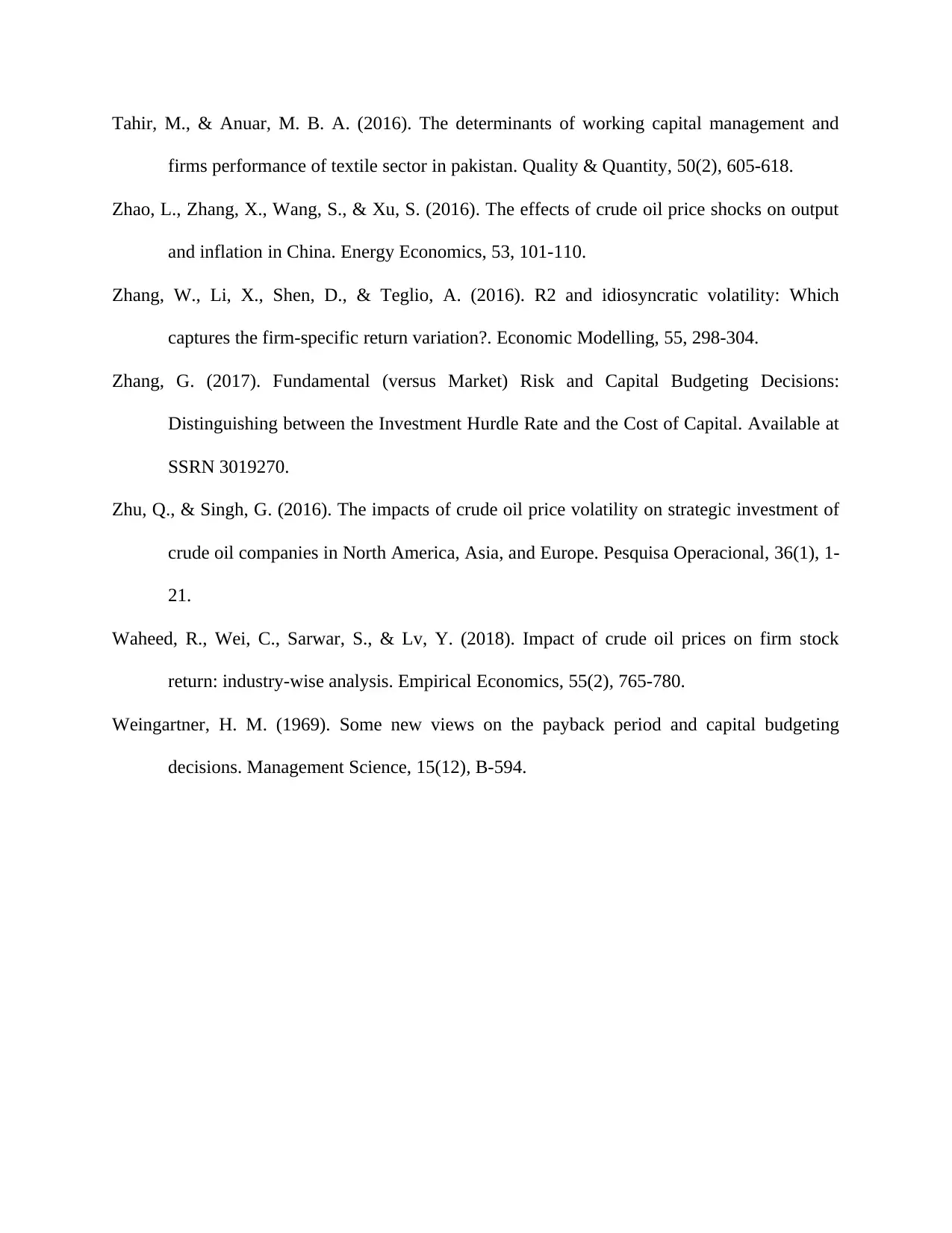
Tahir, M., & Anuar, M. B. A. (2016). The determinants of working capital management and
firms performance of textile sector in pakistan. Quality & Quantity, 50(2), 605-618.
Zhao, L., Zhang, X., Wang, S., & Xu, S. (2016). The effects of crude oil price shocks on output
and inflation in China. Energy Economics, 53, 101-110.
Zhang, W., Li, X., Shen, D., & Teglio, A. (2016). R2 and idiosyncratic volatility: Which
captures the firm-specific return variation?. Economic Modelling, 55, 298-304.
Zhang, G. (2017). Fundamental (versus Market) Risk and Capital Budgeting Decisions:
Distinguishing between the Investment Hurdle Rate and the Cost of Capital. Available at
SSRN 3019270.
Zhu, Q., & Singh, G. (2016). The impacts of crude oil price volatility on strategic investment of
crude oil companies in North America, Asia, and Europe. Pesquisa Operacional, 36(1), 1-
21.
Waheed, R., Wei, C., Sarwar, S., & Lv, Y. (2018). Impact of crude oil prices on firm stock
return: industry-wise analysis. Empirical Economics, 55(2), 765-780.
Weingartner, H. M. (1969). Some new views on the payback period and capital budgeting
decisions. Management Science, 15(12), B-594.
firms performance of textile sector in pakistan. Quality & Quantity, 50(2), 605-618.
Zhao, L., Zhang, X., Wang, S., & Xu, S. (2016). The effects of crude oil price shocks on output
and inflation in China. Energy Economics, 53, 101-110.
Zhang, W., Li, X., Shen, D., & Teglio, A. (2016). R2 and idiosyncratic volatility: Which
captures the firm-specific return variation?. Economic Modelling, 55, 298-304.
Zhang, G. (2017). Fundamental (versus Market) Risk and Capital Budgeting Decisions:
Distinguishing between the Investment Hurdle Rate and the Cost of Capital. Available at
SSRN 3019270.
Zhu, Q., & Singh, G. (2016). The impacts of crude oil price volatility on strategic investment of
crude oil companies in North America, Asia, and Europe. Pesquisa Operacional, 36(1), 1-
21.
Waheed, R., Wei, C., Sarwar, S., & Lv, Y. (2018). Impact of crude oil prices on firm stock
return: industry-wise analysis. Empirical Economics, 55(2), 765-780.
Weingartner, H. M. (1969). Some new views on the payback period and capital budgeting
decisions. Management Science, 15(12), B-594.
1 out of 28
Related Documents
Your All-in-One AI-Powered Toolkit for Academic Success.
+13062052269
info@desklib.com
Available 24*7 on WhatsApp / Email
![[object Object]](/_next/static/media/star-bottom.7253800d.svg)
Unlock your academic potential
© 2024 | Zucol Services PVT LTD | All rights reserved.





